
When My World Was Young 1945-56 The Yellow Brick Road 1956-60 What a Wonderful Town 1960-61
Wonderful Town (pt. II) 1962-66 The Gay Sixties 1966-70
The Juicy Life 1971-76
Juicy Life (pt. II) 1976-80
Losing Alexandria 1981-87
The AIDS Spectacle
Losing Alexandria (pt. II) 1987-1990's
CONTINUATION: The Juicy Life - Part
II (1976 -1980)

HOME SWEET HOME: DRUGS, MURDER, GENTRIFICATION AND "DISCOMANIA"
Two years in a tiny studio was enough, and at the end of my lease I got a chance to move to a much larger one-bedroom corner apartment on the seventh floor. The view from the apartment was terrific, and I had enough money to furnish it simply so that for the first time I was able to create a living space for myself that definitely looked and felt like it was comfortably mine. But life on the block down below didn't change during the next few years. Off and on during the night I'd be awakened by small groups of guys arguing or fighting in the street below, and there was worse. The Times did a major story on the first page of its second section (the page that usually featured articles on life in the city) on the times and crimes on West 80th. The burglaries, prostitution and violence ranked as minor activities when compared to the businesses of two major heroin dealers on the block. The story described how one, a Hispanic family, managed to repeatedly outfox the police even when raided. The kids on the block were employed as lookouts and messengers, and one family of new residents on the block had even recovered their stolen stereo equipment through the "good offices" of these kids.
One day in 1974 someone rang my door bell
which was immediately followed by a knock on the door this meant whoever it
was was in the hall, and not ringing from the lobby. I thought it was probably
Bob, the super, or maybe my friend, Don Pileats, from the top floor. 
But it wasn't a familiar face I saw through the peep hole, and when I opened the door a crack the guy held up a police badge, though he was in street clothes.
He came in, and showed me a photo they were looking this
guy, and maybe I had seen him...and maybe in bars in the neighborhood...maybe
gay bars in the neighborhood. The photo didn't ring any bells, but he
asked me to contact him if I heard anything about this guy. The young man
in the photo was a cop on suspension because of an alcohol problem; he was married and had been
dealing very badly with an attraction to men.
Then he had been found expertly cut up into seven pieces and left in plastic bags
with the trash in front of my 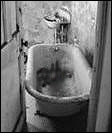 Chinese laundry on 79th Street. (These
laundry guys weren't any luckier than the one on 72nd when I had lived down
there!)
Chinese laundry on 79th Street. (These
laundry guys weren't any luckier than the one on 72nd when I had lived down
there!)
Butchering in a bathtub.
His murderer was found very quickly he had an apartment in number 165, a few buildings farther down our block. He lived with his girlfriend, and he was an unemployed assistant butcher. How and where and why he picked up this troubled cop I never read in the papers. But he did, and took the guy back to their apartment and butchered him in the bathtub. But for what reason? This cop-killer was himself killed in jail and, thus, never came to trial. The mystery of the "why" of the murder remained a mystery.
Our block was clearly on a cutting edge alright, but
not the one that had anything to do with gentrification. However, the stretch of Columbus Avenue below 79th Street,
which I could see 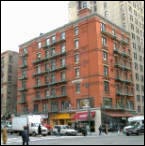 from my windows, was changing. And much quicker than I would
have guessed.
from my windows, was changing. And much quicker than I would
have guessed.
This red brick building is typical of those which lined both sides of Columbus Ave. in the 70's.
At first young entrepreneurs, some of them gay, opened up shops in old premises vacated by stores that had sold paint, hardware, hair dressing supplies, etc. One new business was a huge barn of a place selling a mixture of antiques, junk and cheap ethnic merchandise it was jammed, and let out space on concession. Another was a place called Cheese and Things (I think), and one of its owners was a guy who had posed for the photographer Michael Rock, and his Rock Shots line of cards. Chuck Garr, a gay guy who would become my best friend, opened a plant store which specialized in succulents and cacti. A straight couple had a store which sold wooden and windup toys, games and unusual ethnic and imported clothing. One of their items was a good quality, ribbed undershirt from Portugal, which they had screened with various large postage stamps on the front for awhile these were popular with gay men in the neighborhood.
One of these new places yet another selling "antiques" and some vintage clothing achieved renown through a very clever ad. One of the partners was a straight woman, the other, Jeffrey a gay fellow with a Santa Claus face and similar proportions. The Blackglama corporation, a furrier, was famous for its very simple, beautifully photographed ads featuring famous actresses, each was swathed in a full-length mink coat, but otherwise bare limbed, suggesting that this was all they had on these women, of course, being instantly recognizable, were never identified in the copy, and the headline of the advert was always the same: What Becomes a Legend Most? When Jeffrey's store acquired a cast-off mink, he had a stroke of genius. They bought some pricey space in New York magazine. And there under copy asking: What Becomes of Most Legends? was a seemingly nude Jeffry, posed with sultry hauteur, the second-hand mink slung over one shoulder and clutched suggestively about him, though he accessorized it with a large man's watch and expansion bracelet.
Another legendary female was "Rollerina", a drag queen sometimes seen skating through the Columbus Avenue traffic dressed in what looked like a tattered wedding dress, and wearing jewelled sunglasses and a tiara. She also carried a wand with which to dispense fairy magic on her travels.
These places were the first wave of an extreme change in the commercial face of Columbus Avenue entrepreneurs with a trendy idea and a few cans of paint. The neighborhood had already been sprouting new restaurants the Red Baron, no longer a new place, Teachers, the Library, O'Neill's, Anita's Chili Parlor wildly trendy for awhile, and others. Ruell's and Ruskay's (the latter opened by the guy who was to resurrect the Empire Diner in Chelsea) were two more. Ruskay's may have been the first establishment in the neighborhood to create an enclosed sidewalk cafι. There were so many in a few years that they impeded pedestrian traffic, and there was a big row with the city authorities about them.
On the other hand, the Cherry restaurant, one store front down
from the southwest corner of 76th and Columbus, was close to a
venerable institution I have no idea how long it had been open. When I moved
to West 80th Street in January of '72 I hadn't heard of it, and Don
insisted that we eat there the first Sunday night after I had moved into the
studio apartment. 
It was almost literally a hole-in-the-wall: maybe eight booths on one side and a lunch counter opposite for a dozen people or so. It was run by a Japanese couple, Richard and his wife, who was called "Mama." The menu was pretty much the standard hash house bill of fare, but much better prepared and seasoned than you would usually find in such a place, and served in ample portions at reasonable prices. The meals were often mouth-watering. The Cherry was very popular, and got plenty of gay customers. On Sunday nights there was always a line.
The counter waiters and cooks were youngish Japanese men, amiable and chatty. Then there was Betty. Ah, Betty. She was a white American woman, in her forties perhaps, who waited on the booths. There was never the slightest doubt that Betty thought most of her customers were a pain in the ass, probably stupid into the bargain, and in need of an unrelenting strong hand. Although I don't think that she ever resorted to a cleaver, as Chris at "the Greeks" had done, her personality was an adequate substitute. Short and stocky, with a dry, challenging voice and the charm of Madame Lafarge, Betty was adored and obeyed no less than H. Rider Haggard's She.
By the closing years of the decade, incredibly expensive clothing stores and boutiques were opening on Columbus Charivari, Design Observations, Betsy Johnson and on some signs, "...of Paris, London and Columbus Avenue" appeared, and they weren't kidding. Traditional neighborhood merchants were driven out wholesale, and residents now began to have to find more of their daily necessities in shops on Amsterdam Avenue. Nevertheless, there was no comparable level of gentrification taking place on Amsterdam, and quite surprisingly one of the newer stores on that avenue was Arara, a Hispanic store of some sort on the NE corner of 76th quite an odd addition for a neighborhood whose Latino population in that area had practically vanished. I was passing by Arara on my way to Boot Hill on the night before they opened. The windows had been completely covered with sheets of thick butcher paper on the inside, but the place was obviously light by candles, and I could clearly hear the sound of drums and chanting...strange! It wasn't until the store opened the next day that I discovered it was a botαnica, and it had obviously been consecrated with a Santerνa ceremony that night. Later a small lunch counter just a few doors from Boot Hill, run by a Puerto Rican lesbian and very popular with gay men, was the scene of a Santerνa exorcism ritual. Lots of the gay guys who lived around this stretch of 76th and Amsterdam were aware of these things and seemed to take them in stride, but I did wonder how aware the straight whites in the neighborhood especially the newer arrivals were about this, or even about the extent of the burgeoning gay male subculture around them.
The Cherry, however, not only held on Columbus it thrived! Richard eventually expanded his tiny diner-like restaurant into a large store (or maybe it had been two stores) next door. Betty disappeared, replaced by a very hip Japanese waitress, Cheiko, and a changing assortment of young white men (often gay) and women. Richard had never been other than friendly to gay men, and his expanded place got a large, steady clientele of them. "Mama" continued to reign from behind the cash register, a very made up, well-coifed dumpling who always reminded me of the court beauties of Heian Japan, unfailingly pleasant, though sometimes appropriate to that resemblance a bit world-weary it seemed. Perhaps she was nostalgic for the old days when the Cherry had been a small, humble establishment ruled by Betty's lash.
Residential real estate was renovated at an even faster pace between 72nd and 79th it seemed. The old rooming houses owned by the second and third generation of their original immigrant owner's families were rehabbed into modern apartments. Some brownstones were purchased and turned into private homes again.There was a flip
side to this boom picture on the Upper West Side, and it was taking place in the
large, old residence hotels which lined the avenues. By the end of
Lindsay's final term in 1973, the number of persons on Welfare had doubled from
what it had been eight years before. Increasing numbers of these people
were being housed at the City's expense in these hotels. Thus, as the
neighborhood was becoming more upscale on one hand, it was also gaining unemployed, poor
and in many cases, drug addicted
inhabitants. As it
lost Hispanic and black rent payers to gentrification, ironically it gained
minority residents who were homeless and impoverished. Whereas in the
mid-Sixties the Endicott Hotel on Columbus and 81st had been a notorious standout, now
there was a growing number of similar establishments: the Upper West Side,
the grand neighborhood of yesteryear once heralded as the "American Belgravia", was studded with these decaying old palaces, and they
took a new lease on death in the Seventies as "welfare hotels."

(right) The new workplace, a glass-walled skyscraper
The temp job I'd gotten at the Central Office of the City University of New York (CUNY) "just for the summer" in May '73 had led to the offer of a permanent slot that fall. I was now working in the University's newly created central computing facility, which was located only about fifteen minutes away from my apartment by bus in a new highrise near the end of West 57th Street and across the street from the CBS Broadcast Center.
Having a permanent position at CUNY now, and the move to our new quarters resurrected the issue of being out at work. At Baldridge from the mid-Sixties to the end of my employment in '71, I was out but it was not talked about the elephant in the living room thing. Working for Ken and his partner, the atmosphere had been totally different: Ken was gay and there was no secret about it, though it was not an everyday topic of conversation with the clients, and my sexuality, therefore, was automatically a non-issue there. During the summer months at CUNY, when I'd just been a temporary worker, though surrounded by other staff, no one paid much attention to me by and large. Pretty soon I became the one-man clerical staff for the three newly hired honchos who were to be the top level management of the new computer center.
Now that we were in our new quarters, however, with a rapidly growing staff and being cheek by jowl with folks I would spend a large part of my life with, the question reasserted itself. I did not want to try to go back to passing (though I doubt that would have been a very convincing act), nor did I even want to mask who I was; but, I really hadn't a clue quite how to manage coming out. But Fortune grinned. I shared an office with a voluble, hip somewhat older Jewish woman. At some point early on, after a weekend, I think, we were chatting about what-did-you do, and I found myself uncomfortably dodging her conversation. In a moment of frustration, as much to excuse my rudeness as anything, I think, I said, "I'm gay, you know." She looked as me in a puzzled manner, and said, "Yes, I know," in a tone that implied: well, sure, why are you saying this. There was a pause, and being a very perceptive person, I think she grasped then that this moment a big deal for me, and she smiled, shrugged her shoulders and said, "It's okay."
And, indeed it was. From that moment at work on my life was as much of an open book as anyone else's. In the early days this stopped a very small number of people dead in their tracks a few times, and I think being an out person on the staff so early in the life of the organization definitely helped set a tone that helped the place become quite gay positive. One of the most supportive people was Clyde, the Associate Director for Operations. He was the only black person on the staff, other than some of the work-study interns who rotated every few months. He clearly felt a bit uncomfortable in the environment sometimes, particularly as his manner of dress and his lifestyle were considerably different from any other members of the administration or staff. He dealt with race provocatively, but tricked out with blunt and outrageous humor. Inspired by Clyde, my own approach to the gay "issue" was blunt, but dead pan humor.
I had a low level administrative spot, but I liked the environment, by and large, and the pay and benefits were decent. I read Lawrence Block's When the Sacred Ginmill Closes just a few years ago, and was surprised to find that it is set in this neighborhood during these same years so, all the restaurants and bars which figure very prominently in the story were totally familiar to me. If you've read this mystery, you know what this neighborhood was like back then. The novel's title comes from a Dave Van Ronk song. (He was the (straight) folk singer the cops pulled into the Stonewall with them the night of the raid and riots in '69.)
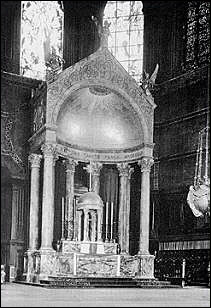 There was great bookstore at 57th & Broadway, the Coliseum,
which was a good place to pass a lunch hour. But if you wanted to sit down
and relax in peace, or read, there wasn't anyplace in the neighborhood.
Then I investigated St. Paul's Church, a big Late Victorian pile, at 9th Ave. &
60th, the mother church of the American order of Paulist fathers. With a
large and plainly awful high relief blue mural on the front it's hard to miss. Dry in
bad weather, cool in hot weather it was great, except for the seats.
There was great bookstore at 57th & Broadway, the Coliseum,
which was a good place to pass a lunch hour. But if you wanted to sit down
and relax in peace, or read, there wasn't anyplace in the neighborhood.
Then I investigated St. Paul's Church, a big Late Victorian pile, at 9th Ave. &
60th, the mother church of the American order of Paulist fathers. With a
large and plainly awful high relief blue mural on the front it's hard to miss. Dry in
bad weather, cool in hot weather it was great, except for the seats.
Stanford White designed the main altar in St. Paul's.
Most visitors headed up to the front for a mass, or at least to pray, and I sat in the back and read, or sometimes just cooled out if work was shitty that day. The building has some historical interest, and strolling around it could be interesting for a short while, and in the lobby there was a bookstore not entirely devoted to prayer books, holy cards and rosaries. This is where I picked up a small book of selections from the suspected Medieval heretic, Meister Eckhart, one day when I had nothing to read. His name rang a faint bell from somewhere. And I started learning about something called the via negativa, though I read only here and there in the book before I put it away for several years.
The infallible wisdom of hindsight has shown me that buying this particular book, and using St. Paul's as a chapel-of-ease and reading room, was the very beginnings of coming to terms with my unexamined assumptions about having a hibernating Catholic/Christian faith.
My new apartment upstairs looked good, and felt like home. I'd gotten help with fix-up projects from Don and other friends from the neighborhood bars when I'd needed it.
I liked the view down Columbus Avenue, and I'd often notice Bob, the super, sitting on one of the park benches across the street, under the plane trees along the fence behind the museum of Natural History. Some of the other bench denizens looked like a rough bunch. He seemed to be out there a lot lately, but while his wife lived in the Bronx, he'd told me, some of his sons in their late teens and early twenties were often living with him, and maybe that gave him spare time because he kept the our old building clean and running well. Bob and I got on, and if I needed him to do something I usually sat around and talked with him for awhile when I stopped by.
Once a month I bussed it across town on my lunch hour to get an Z of grass from the by now entirely too talkative Stanley of Sutton Place, visits that left me sneaking desperate peeks at my watch while he waxed on as if I had all day to shoot the breeze with him. At night I might come home and after dinner blow a joint and listen to WBLS until I was ready to turn in. Once Russell had turned me on to it I had opened the window and let Alison Steele, the Nightbird, fly out for good. From then on it was Frankie Crocker, Lamarr Renee, Ken Webb and the rest of the BLS gang who supplied the music in my life. I did, however, buy Gloria Gaynor's non-stop, three-number disco album Never Can Say Goodbye, and spent some time spinning around the living room in a hebephrenic frenzy.
My only gay reading that I remember while was living here
was Warren's Front Runner, Consenting Adults by Laura Hobsen, a novel
about a mother dealing with her son coming out (it became almost a
textbook on having-a-gay-son 101 that some guys handed their parents far too
late for mine, though) and The Homosexual Matrix by C.W. Tripp,
the latter I recall as an acceptable, non-groveling explanation of
homosexuality. The gang of guys that I'd been hanging out with since the late
Sixties all went down to the Public Theater to see Chorus Line in '75,
and we thought it was great entertainment, with a even-handed,
matter-of-fact treatment of gay people. Later it moved to Broadway, and,
as they say, the rest is history.
Fred Halsted
On a grittier level, I took in Fred Halsted's new flick, Sextool.
Kansas City Trucking Co. (1976) was the first film in a trilogy by filmmaker Joe Gage, and was followed by El Paso Wrecking Corp. (1977) and L.A. Tool and Die (1979.) Gage's films of the second half of the Seventies managed to combine road film/buddy film/fuck flick into something akin to pornographic lyricism, an imagined world of gay men leagues away from any imitation of boy-meets-girl.
My friend Charlie Collins and I were still sleeping together on a catch-as-catch-can basis, and we went out together a lot for dinner and barring. And there was now much more activity in the neighborhood too as far as gay life went.
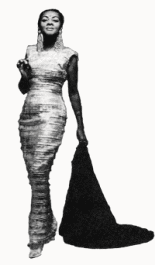 The Westsider, never very popular, tried to make it as a
cabaret called the Speakeasy. It was managed by Larry Clinton, who was
popular in the neighborhood from working the Candlelight and later the Picadilly. The
bar was large and circular, so the raised shelf area in the center could serve
as the stage.
The Westsider, never very popular, tried to make it as a
cabaret called the Speakeasy. It was managed by Larry Clinton, who was
popular in the neighborhood from working the Candlelight and later the Picadilly. The
bar was large and circular, so the raised shelf area in the center could serve
as the stage.
(right) The very, very talented Dawn Hampton
It worked perfectly, and the acts were very good Dawn Hampton appeared several times and was at the peak of her career as a singer, having been dubbed by the New York Times as the "Lady of Cabaret." Two others were Rosalind Kind, Barbara Streisand's half sister, and Paula Lockhart a singer full of piss and pizzazz, who had come to public attention as the soft and sultry commercial voice of Carolina Rice. I took some straight people from work there the place was so good, but for whatever reasons it could not sustain itself as a cabaret and closed in six months or so. It was a brief, but very fun, period in the Seventies West Side gay scene.
This had left the Picadilly, the Bike Stop, and the Candlelight by 1974. However, at this point gay bars suddenly mushroomed in the neighborhood, due at least in part, I'm sure, to an influx of more white gay men into the changing neighborhood.
Kitty-corner from the Pic, and only a few doors from the
Candlelight, was a brightly lit, under-patronized boozers' bar that looked like
it had been the model for Edward Hopper's famous late night cafeteria painting.
It closed and overnight, it seemed, Nefty, who had created the Pic, covered the
facade
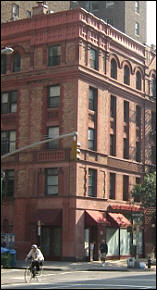 with barn siding, closed most of the windows, put down rough planking
over the tile floor and nailed a homemade sign above the
door saying "Boot Hill."
with barn siding, closed most of the windows, put down rough planking
over the tile floor and nailed a homemade sign above the
door saying "Boot Hill."
Former Boot Hill bar, ground floor corner with red awnings, 75th & Amsterdam
Very soon after, around the corner on Columbus, someone opened a rustically decorated place, but not Western looking like Boot Hill, called Wildwood. One of the early bartenders there was Nathan, who had been in on the beginning of the Pic. (Though in the same skin tight jeans, he was no longer sporting the monster basket he had shown when he debuted at the opening of the Pic, thus giving credence to the rumor that it really had been a sock full of laundry.) He was deeply smitten with a handsome former model, John Chambers (later one of the owners of Les Mouches club.) Nathan had a local gay artist, best known for rather sentimental iconic portraits of movie queens, paint a portrait of John shirtless, in tight jeans, leaning against a tree in a woodland glade a kind of romantic, soft-focus take on Tom of Finland. And he hung it in the bar. Nathan went elsewhere eventually, the bar changed hands, but the portrait remained much to John's embarrassment. I wonder where it is now?
An after-hours dance bar, Cinderella Man, opened briefly
during this time it lasted less than two months probably. It was located in
the basement of an apartment building just a few doors in from West 77th
and Columbus. The first time I entered the space it seemed immediately
familiar. It had clearly been a large, purpose-built nightclub or restaurant,
though not of recent vintage. It took me a while and then I remembered: On one
of my trips to NYC in my Junior year at Syracuse, I had gone with Rob Manahan
and a couple of other guys to a basement gay bar on the Upper West Side, a dark,
going-to-seed place whose glory days were long gone. Rob had claimed that it had
once been owned by Texas Guinan, and then had to explain who she was to me.
But it probably had not been one of her establishments. 
Texas born Mary Louise Cecelia Guinan left Waco, and had a brief career as a cowgirl in silent Westerns. Unsatisfied, she headed to Gotham to find work as a nightclub showgirl. But she quickly opened her own place and became the Queen of New York Nightclubs running a series of popular wide-open Prohibition Era speakeasies. She used to sit on the piano of her establishment, greeting her customers with a cheery, "Hello, sucker!"
"Hello, Sucker!"
Stanley Walker, City Editor of the Herald Tribune, described her as combining "the curious and admirable traits of Queen Elizabeth, Machiavelli, Tex Rickard and Ma Pettingill . . ." Her attitude toward the police was so cavalier and theirs hardly more serious that when they entered a club to arrest her, she'd have the orchestra strike up The Prisoner's Song!
And now, fifteen years later, here I was again. What had changed was that the place had now been stripped of almost every decorative gewgaw that had still remained when I was there in 1959. However, as a dance bar, much less a disco, Cinderella Man was a flop. Though the space was huge and the dance floor in great condition, the only music was a juke box with a pretty crappy selection of music. The place became an after-hours bar for boozers and lasted even a shorter time than one of Guinan's speakeasies.
It was sometime around this period that I tried psilocybin (around '74, maybe) and the experience was horrible. I was in my own apartment and my good friend Charlie and I each took a hit the conditions should have been psychologically ideal. I began having relatively mild visual hallucinations and sensations of floating and spinning soon followed by paranoid delusions in which I was convinced that Charlie intended to kill me! In a panic I calculated that if I could seduce Charlie and keep him in the sack I would be safe. Now Charlie and I had been having sex for years, and the idea that I would need to seduce him was surely an excellent measure of how just how flipped out I was. Well, this life-saving plan of mine did succeed. After what was a marathon session in the sack; when we were both coming down from the drug and pretty wasted, Charlie remarked that the sex had been "strange." How so? He said that I had been very..."voracious," and, in fact, I had scared him! (I mean, what the hell! when you're fucking for your life....) After that I never tried anything hallucinogenic.
And it seemed that around this time any friends who had been into regular acid trips began to stop using it. Grass seemed to be the drug of choice with everyone I knew (and poppers), and I don't recall guys using coke yet.
The Picadilly Pub closed, but five other gay places had opened Fulton's, a restaurant/bar near 72nd and Bway; the Nickel Bar on 72nd between Columbus & Bway; the Main Man (it had a short life), on Columbus practically across from Wildwood; the Works at Columbus & 81st and Half Breed on Amsterdam in the upper Sixties. The Wildwood briefly tried a Sunday afternoon tea dance with terrific tapes (from Richard Brezhner, as I recall), but the dance floor - a small space at the back end of the bar was too small to work. In 1978 the venerable former Candle Light Lounge (aka the Candle Lounge, the Candle) was shut down when its nominal licensees were declared to be a front for the actual owners, the ubiquitous Sonny and Jennie Tobin. Robert Ader, a neighborhood gay lawyer, bought the place out, and after a court row over brand rights with Moe/Maureen, a former bartender, who had designed the bar logo, the decks were cleared for him to renovate and reopen. By the time the dust had settled there were eight gay bars operating in the area between Columbus and 80th and Amsterdam and 69th where ten years before there had been only one.
More bars, but different people.
By and large I divided my time between Boot Hill and Wildwood, with occasional forays into the Candlelight, which is pretty much what most of the guys I knew did. Many things changed in the bars in the latter part of the Seventies: the mechanical shuffle board games and pinball machines were replaced, by the less obnoxiously intrusive Pacman and later other similar machines, but these soon lost out to pool tables, at least in Wildwood and later the Candle...as well as in the other bars, like Half Breed, that I almost never went to.
The giant beer openers mounted on the bar top disappeared when pop-top beer cans were introduced. I do remember a couple of bartenders, though, who thought these huge openers would be more efficient and tried to continue using them. (Closet Luddites probably.) They soon discovered that they mangled the shit out of the tops of the new cans the tops were made of softer metal now so that the pop-top tab would come free easily.
And that venerable American icon the jukebox also vanished, replaced by tapes and tape decks.
 Some people also disappeared, not just particular
individuals, but entire groups of people. First to go were any of the white
guys I had known who had minimum wage (or worse) jobs Denny, the hash house waiter,
Rich, the ticket-seller in a porn theater, Brad, the cleanup man in a bar. Their
residence hotels
were filling up with welfare clients, and with them came noise, drug addiction,
prostitution and fights and the occasional murder. Rick and Wayne, two waiters, living in different hotels in
the neighborhood, were burned out of their rooms in fires started by drug
addicts.
Some people also disappeared, not just particular
individuals, but entire groups of people. First to go were any of the white
guys I had known who had minimum wage (or worse) jobs Denny, the hash house waiter,
Rich, the ticket-seller in a porn theater, Brad, the cleanup man in a bar. Their
residence hotels
were filling up with welfare clients, and with them came noise, drug addiction,
prostitution and fights and the occasional murder. Rick and Wayne, two waiters, living in different hotels in
the neighborhood, were burned out of their rooms in fires started by drug
addicts.
Quite a few of the Latino guys vanished as well. If they lived in buildings filled with low-rent apartments (and especially ones with many minority tenants) these were the prime building candidates for rehabbing the purchase cost of such buildings was usually low, the turnover of apartments was often fairly rapid due to the precarious employment situation of many tenants (which meant vacant apartments accumulated faster than in a building with middle class tenants), and the minority tenants who remained were often unsure of their rights and unable to hire legal counsel and, therefore, in the end could be forced out or bribed out cheaply. Of course, there were Hispanic guys in the neighborhood who were in better employment situations, and who had held onto the same rent controlled or rent stabilized apartments for years and they remained.
One peculiar innovation for the neighborhood was the Nickel Bar on 72nd Street. It had been a straight place, but when it opened as a gay bar yet another place reputedly owned by Jennie Tobin I stopped by. The establishment had one unusual feature, a genuine old fashion metal-covered bar top. There were a dozen or so customers white, Hispanic and black and the two bartenders were familiar (white) faces who had worked in other place's of Jennie's. (One of Jennie's employees there, Ted Fay, would a decade later be managing a midtown gay bar for blacks and other clubs, when he was gunned down on Third Avenue in a mob hit.) A week or so later when I went back to the Nickel Bar most of the customers were black and Hispanic, and only one of the bartenders was familiar. Larry Clinton, who had been going to work there, told me that it was going to be a black bar. I was a bit confused at first, thinking he was making a prediction, but he corrected that it was intended to be a place for black customers. Odd, I thought and still do when the neighborhood had had a large Hispanic population, and the area was now so clearly turning rapidly whiter than it had been since the end of WW II. Why create a bar for black men in the neighborhood? Nevertheless, it was true, the customers were mainly black and a much smaller number of Hispanics. The Nickel Bar had problems with its residential neighbors because its customers hung around outside the bar in a large noisy crowd when it closed, which was not the case with the other gay bars. My guess is that, at least in part, this may have been because most of them didn't live in the neighborhood, and, therefore, going "around the corner," so to speak, to hang out in someone's apartment wasn't an option.
The former Cinderella Man turned into a mostly black straight dance club in the Eighties, and caused the same problem for the residents around 77th and Columbus very large, noisy crowds in the street after closing. I can remember at the time that the cops pointed out that the patrons were not from the neighborhood, and that at 4 a.m. there was no place open for them to congregate, so they hung out in front of the place or across the street by the Museum of Natural History's fence.
With the large increase in gay bars it was clear that many new gay guys were moving into the neighborhood now that it was getting a better reputation. Just walking down the streets told you that. Most of these were white. However, they arrived in the neighborhood several perches higher on the socio-economic totem pole than those of us who came into the neighborhood in the Sixties had been at when we arrived. With tongue-in-cheek, a friend of mine characterized these guys as "the fruits of gentrification." While the blocks in the Sixties, Seventies and Eighties were obviously getting a larger gay male population and developing a more visible gay presence in their commercial life, the area could never, in my experience, have been labeled a gay ghetto. Unlike Cherry Grove, which was a classic closed off ghetto community, or even the West Village of the 70's, which between its gay residents and gay tourists and visitors had developed in the Christopher/West St. area something close to the Cherry Grove community, this was not the case in our neighborhood.
Gay life on the Upper West Side seemed to operate in something more like a parallel mode. Yes, there was a large gay male population which patronized gay businesses and worked in these and non-gay neighborhood establishments, but there was a strong sense of neighborhood on the Upper West Side but this burgeoning of gay life was so recent that most guys I knew already had a very well developed sense of being West Siders and not just members of a gay West Side only. I should mention that the neighborhood was also getting an influx of young, straight white singles too, something which has happened in other rundown neighborhoods where white gay men settled in first.
One of the most noticeable and significant changes in gay life overall in the 70's was the much larger number of men in their late thirties and forties in the bars, and multi-generational socializing and tricking. This seemed particularly marked in leather bars downtown, though far less in evidence in dance clubs, however, places such as Boot Hill and the Wildwood, and many Village bars had no lack of "older" guys.
One sign of the new neighborhood life was the appearance in '76 of the Grand Finale on 70th west of Amsterdam. This was virtually the same place as had existed in the Village in '59 and had managed to survive the Wagner closings, same name and same management, but transplanted to much larger quarters on the increasingly prosperous and increasing gay Upper West Side. It began as a gay place, however, that changed, due probably to a superficially classy restaurant atmosphere and the introduction of entertainment. One night I went there with Van, a guy from work whom I was seeing. I had hired him as my boss's secretary and for that reason was certainly not interested in having the extent of our relationship known at work. We were seated, and when I glanced at the couple at the next table on the banquette - whoops! - the guy was one of the managers at work. Since the cat would undoubtedly be out of the bag sooner rather than later, when shortly afterward my office mate and his wife invited me to a party at their home, attended by all the upper level staff of the Computer Center, including my boss, I brought Van as my date. The initial reactions ran a gamut from none at all to amusement (at the discomfort of a couple of tightasses) to a couple of cases of high anxiety. But it was, I think, just one of the many moves by gay people who worked at the West 57th Street part of the CUNY Central Office which made it a truly gay-accepting workplace, whereas the main part of the Central Office on East 80th Street remained overall rather the opposite.
The ethnic neighborhoods which had once given me a sense that I was living apart from the U.S. of A. and, thus, insulated from some of the more repugnant and dangerous aspects of Middle America (not entirely a fantasy) were almost gone. Our part of the Upper West Side had lost its Latinos, many Irish had fled Washington Heights and were long-gone from Third Avenue, the German and Czech population of Yorkville was reduced to dying pensioners, the Ukrainians had left the East Village, Little Italy was dying and on it went. (But the Chinese not only stood their ground, their old Chinatown enclave was spreading.) A kind of homogenization had taken place in Manhattan, so that from north of Canal Street to the upper reaches of Central Park there was a more or less pervasive cultural sameness vestiges of ethnic and racial minorities notwithstanding.
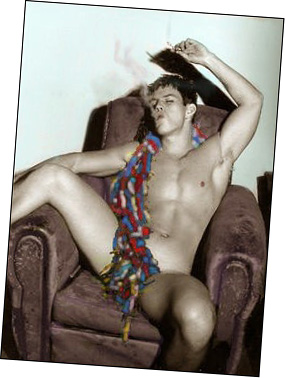 However,
the influx of a large number of gay men into our neighborhood was in some
respects a kind of counter-force. Though ethnic identification seemed to
have lost its importance among gay men of European ancestry, the prevalence of a
thriving gay life, on the other hand, made the gay sexual identity itself into
something approaching a virtual ethnicity a phenomenon that I believe the
annual Stonewall parade on Fifth Avenue strongly reinforced.
However,
the influx of a large number of gay men into our neighborhood was in some
respects a kind of counter-force. Though ethnic identification seemed to
have lost its importance among gay men of European ancestry, the prevalence of a
thriving gay life, on the other hand, made the gay sexual identity itself into
something approaching a virtual ethnicity a phenomenon that I believe the
annual Stonewall parade on Fifth Avenue strongly reinforced.
The
Bicentennial celebrations and other events provided an opportunity
for the new gay arrivals to exhibit their native customs to the
neighborhood.
So, here was the latest of the "ethnic" waves that had rolled through the Upper West Side in numbers large enough to be highly visible, inserting themselves into the established life of the neighborhood, yet at the same time making their own separate spaces as well. And, of course, this They was more of me and my friends. I found myself feeling even more separate from the Trans-Hudson Outback now especially as in the late Seventies I met gay European and South American visitors to the city and became aware of how easily and comfortably they moved between New York City and their home countries.
Chuck Garr, the plant man, who had quickly become a good friend, pounced on me one day in the early fall of '75. His store was a clearinghouse for neighborhood news and gossip both straight and gay and he had just found out about a large, very cheap two-bedroom apartment in a newly renovated building down in the mid-Seventies between Columbus and Amsterdam. A customer of his, Tom, whom I knew only slightly, was dying to move into it, but needed a roommate. And this was going to be me. Uh, right. Chuck had an overweening need to arrange other people's affairs, and moved through his friend's lives like a combination Jewish Mother and Storm Trooper. Resistance was usual futile or even lethal to your friendship.
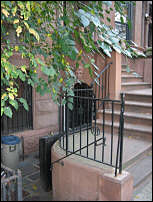 However, this time maybe he was
onto something. The rent was very good, Tom lacked any obvious signs
that might have inclined me to believe he was an axe murderer...and much as I
liked my present apartment, there was no way I could argue that moving away from
80th Street to the mid-Seventies wasn't a big plus.
However, this time maybe he was
onto something. The rent was very good, Tom lacked any obvious signs
that might have inclined me to believe he was an axe murderer...and much as I
liked my present apartment, there was no way I could argue that moving away from
80th Street to the mid-Seventies wasn't a big plus.
112 West 76th, ground floor entrance
Aside from the obviously rough nature of the neighborhood above 79th Street, the walk down to 75th and Amsterdam, where the bars were centered, presented its own problems street lighting was still patchy and dim, and whether one went down Columbus Avenue or Amsterdam, each one required passing large, dark playgrounds where dope dealers and gangs of kids often lurked.
While I was taking a deep breath getting ready to say, weeeeell, I think so, Chuck had already sent Tom to tell the landlady, yes.
Dame Fortune reinforced the wisdom Chuck's decision rather emphatically. Shortly after I had moved to West 76th, Don Pileats, from the old building called me: Had I heard about Bob, the super? No, I hadn't...did he win the lottery? Not exactly, but he was news. I knew that Bob had knocked through the floor of his apartment on the ground floor into a storeroom in the basement, and had put in a stairway and made the downstairs into a "rec room." His rec room activities, I learned from Don, had involved coke dealing, swinging with young men and lots of good time partying. Sheesh! Bob? Maybe his drug business had been why he was over sitting on the park bench so much.
However, something went badly wrong in Bob's version of the Lush Life, and Bob and one of the young guys had been found bloodily slaughtered over drug money the police conjectured in said "rec room." As far as I know, the crime was never solved.
THE GAY LIFE
 The renovations on West 76th had been finished,
and the building finally ready for occupancy in October '75. But suddenly I was
scheduled for admission to the hospital for surgery on the day after I was
supposed to move in, and hardly able to pull together rolling a rug up, much
less carrying a box or moving furniture. As happened other times I'd been in a
tight spot, it was guys I'd met in the bars who saved the day. Chuck-the-Plantman,
Ted, a straight friend of his I'd become friends with, and another guy got everything
moved. Then they brought me down. The next morning I got up, caught a cab
and was admitted to the hospital...two days after the
operation, a day before Thanksgiving, Chuck picked me up at the hospital, brought me home and made me
comfortable on the couch. And Thanksgiving Day Charlie Collins and two or three
other guys came over and cooked a big with all the fixin's traditional
dinner. It was the best and most thankful Thanksgiving I ever had.
The renovations on West 76th had been finished,
and the building finally ready for occupancy in October '75. But suddenly I was
scheduled for admission to the hospital for surgery on the day after I was
supposed to move in, and hardly able to pull together rolling a rug up, much
less carrying a box or moving furniture. As happened other times I'd been in a
tight spot, it was guys I'd met in the bars who saved the day. Chuck-the-Plantman,
Ted, a straight friend of his I'd become friends with, and another guy got everything
moved. Then they brought me down. The next morning I got up, caught a cab
and was admitted to the hospital...two days after the
operation, a day before Thanksgiving, Chuck picked me up at the hospital, brought me home and made me
comfortable on the couch. And Thanksgiving Day Charlie Collins and two or three
other guys came over and cooked a big with all the fixin's traditional
dinner. It was the best and most thankful Thanksgiving I ever had.
My roommate, Tom, always had a command performance to celebrate with this day with his widowed mother and his siblings. But I'd had been quickly introduced to our new neighbors in the front apartment: Two brothers from Jersey one gay, one straight both almost overpoweringly outgoing, and totally into being single guys in the city. Thanksgiving evening ended at their apartment next door, with me on their couch instead of my own. The joints went around, the drinks flowed and the music played and played and played...Labelle, ZZ Top, ABBA, Earth Wind and Fire, BT Express, Sylver Convention and more and Carol Douglas with Doctor's Orders a few times to strike an appropriate medical note, in light of me just getting out of the hospital.
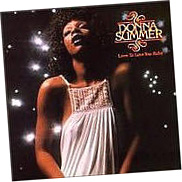 And
Donna Summer's endless song of multiple orgasms, Love to Love You Baby.
It was a long, lush, relentlessly beated moan about love-making and it cried
out for drug enhancement.
And
Donna Summer's endless song of multiple orgasms, Love to Love You Baby.
It was a long, lush, relentlessly beated moan about love-making and it cried
out for drug enhancement.
This was the first time, I can recall hearing Phoebe Snow, a non-dance vocalist who wrote her own peculiarly off-beat lyrics and music. One of her best songs was the rather weirdly melancholy "Two-Fisted Lover". The lyrics contained easily decodable references to drugs (several plaints of "Oh help us, MaryJane" and "He's in his space craft") and the ambiguity of some of the other references ("He gives me two-fisted love") led at least some gay men to hear the song as a sly ballad on the outer limits of sex play. This was, of course, the era when the link between Crisco, Mom and apple pie was torpedoed, and Crisco took on whole new erotic image that must have put Betty Crocker's knickers in a twist.
My move down to 76th Street marks a change in the people in my social life which reflects what was happening in the neighborhood at large. I realized as I wrote this narrative that from this point until I moved at the end of the Eighties, I never made any new Hispanic friends in the neighborhood, nor do I remember meeting any new Latino faces as even acquaintances or tricks. I did make friends with a black guy who moved into the neighborhood, though he lived above West 79th, which was in the first throes of gentrification. The Picadilly was a thing of the past, and I had become a regular at Boot Hill even before I moved down from 80th Street. Some of the Latino guys I had known left the neighborhood, and other guys I'd hung out with (Euro-American and Latino) who still remained, drifted to the edge of my social life - even though most of them also patronized Boot Hill. By the end of the decade my circle of friends, like the neighborhood, had become almost totally white, most of them mid-70's arrivals on the Upper West Side.
I think that either Europe must have become more prosperous in the latter half of the Seventies, or the U.S. became a cheaper place to visit as I began to notice gay foreign tourists. My roommate Tom, who usually socialized down in the Village, met several German and French guys visiting the city, and they often stayed with us over the years. During that time I heard more about the gay life of Paris and Munich than that of places like Chicago or Denver.
The middle Seventies saw three highly publicized stories of gay men coming out. The first was decorated Air Force Sgt. Leonard Matlovich, who was dumped from the armed services in '75 for being gay. His story got a Time cover, and almost five years later the courts ruled that the Air Force had to reinstate Matlovich though he accepted a cash settlement offered to him instead.
A few months later David Kopay, a former Washington Redskins lineman, came out and he was buried under hostile comments from sports figures.
The third was the Rev. Malcolm Boyd, an Episcopal minister, with a reputation for being very "with it" and enjoying some celebrity for his book of provocative meditations, Are You Running With Me, Jesus? His coming out in '76 in a New York Times interview provoked a lot of negative reaction, although twenty-five years later would find him as a regular contributor to the monthly AARP magazine .(an organization of retired seniors.)
If the reaction to these people was pretty negative at first, they did show straights that gay people were everywhere in society, and often, it seemed, where straights would have least expected them and excelling in their fields.
Rather strangely, at the time I commented a couple of times in a journal how surprised I was at the amount of negative reaction and its vehemence.
These comments puzzle me now, I was very aware of the higher level of homophobia in places I visited outside of NYC and even near to the city. In Sayville, Long Island for example, the taxi's taking gay men from the train station to the ferries for Cherry Grove and the Pines sometimes got catcalls and obscene gestures as they passed through the town. Through most of the Seventies I felt a suppressed uneasiness on the return trip from the Island, starting at the Sayville dock until we got to Penn Station, because anywhere on that journey unprovoked homophobic remarks or more threatening nastiness could occur. (This situation probably helped fuel the popularity of the private Islanders bus service between NYC and the Sayville ferry, I'm sure.) While things were certainly getting better for gay people, how much better depended on where in the country you were. Considering the wild homophobia that was unleashed in the next decade, my journal comments were very naive, if not just plain stupid.
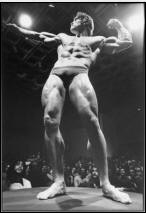
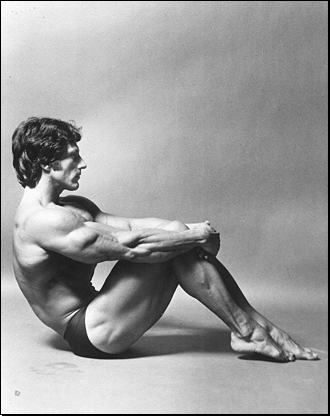 One
of our cultural ventures that winter was a trip to the Whitney Museum in
February '76. The occasion was to see bodybuilders Arnold Schwarzenegger, Frank
Zane and Ed Corny in a posing exhibition in the museum's auditorium! Huh?
One
of our cultural ventures that winter was a trip to the Whitney Museum in
February '76. The occasion was to see bodybuilders Arnold Schwarzenegger, Frank
Zane and Ed Corny in a posing exhibition in the museum's auditorium! Huh?
(right) '76 Frank Zane photo by Ken Duncan
(left) photo of Arnold at the Whitney '76.
The event evidently was tied into an attempt to promote the upcoming film Pumping Iron, though it wrapped itself in a silly academic guise perhaps to assuage the museum's supporters. Amateur bodybuilders, gay and straight, showed up, but it was packed with more just plain ol' gay guys than a tea dance. The posing exhibition was followed by brief talks by five or six academics (some from campuses of my employer, the City University), who made fools of themselves on the topic of whether bodybuilding should be considered an art. With but one shining exception, they were pompous and humorless.
In a windup informal discussion in which the three bodybuilders (now in street clothes) participated, Schwarzenegger performed with the heavy-handed wit that America has since come to expect from him; while Frank Zane, a bright, educated guy, went pleasantly head-to-head with the academics, displaying great charm and obvious intelligence. Sprinkled among the audience were some of the worked out guys I remembered from Riis Park beach. And looking even better! Schwarzenegger was the major supporting actor in the 1976 release Stay Hungry, a dramatic comedy about bodybuilding. And his performance was good enough to win him the "Golden Globe Award for Best Acting Debut in a Motion Picture"! (This "debut" overlooked two previous film roles.) Release of the docudrama Pumping Iron, starring Arnold Schwarzenneger, in '77 is credited with giving what had been a steadily increasing interest in bodybuilding an emphatic boost.
By June Mayor Abe Beame, and soon every other New Yorker and his dog, knew that the city was financially ruined. The City University was a municipally funded collection of eighteen college campuses, the third largest public supported higher educational system in the country (if I recall correctly), so this meant that it was in deep shit. On June 1, 1976 it put us on what was called a "furlough" leave with no pay and closed its doors. Two weeks later it reopened, but in the meantime I took the first issue of Christopher Street magazine with me out to a chaise lounge in the back yard, and got the greatest tan I'd had in my life up to that point. I wouldn't have complained about another week. Bailing out of this financial disaster took years, and for at least part of that time the State took a major hand in running the affairs of the city quite a comedown for the city of New York .
The evening of July 13, 1977 I was sitting in the living room with the back door open trying to catch a breeze. And then the other shoe dropped for New York. At 9:34 the lights flickered and I heard a big sound like "thunk," followed by a hiss everyone's a/c had just died, and I was sitting in the dark. I went out in the back yard and when I realized that the sky was completely dark too, I knew the city had had a major power failure. I couldn't see anyone, but I could hear people, obviously at their windows, taking in the same fact. I'd missed the famous blackout in the Sixties that had brought down the entire northeast of the country and part of Canada, and really felt something like elation that I was going to see the rerun. I thought it would be a carnival while it lasted, and I got dressed to go to Boot Hill around the corner. (What I did not know for awhile was that contrary to the previous blackout in which New Yorkers behaved with incredible panache and goodwill, this time looting and arson would prevail in some neighborhoods. And it started almost immediately.) By the time I was walking down West 76th toward Amsterdam Ave. the street was filled with folks, many of them just lounging on the stoops drinking; some people had put candles in the windows of the front apartments, and quite a few of the brownstones had a lighted candle burning on the large stone newel post at the bottom of their front steps.
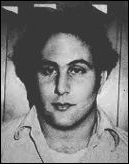 But
there was a bogeyman in the picture. Son of Sam, a serial killer, was
still on the loose in the city. His latest communication to the city had
been a letter to Daily News columnist Jimmy Breslin:
But
there was a bogeyman in the picture. Son of Sam, a serial killer, was
still on the loose in the city. His latest communication to the city had
been a letter to Daily News columnist Jimmy Breslin:
"Son of Sam"/David Berkowitz
"Hello from the gutters of N.Y.C. which are filled with dog manure, vomit, stale wine, urine and blood. Hello from the sewers of N.Y.C. which swallow up these delicacies when they are washed away by the sweeper trucks. Hello from the cracks in the sidewalks of N.Y.C. and from the ants that dwell in these cracks and feed in the dried blood of the dead that has settled into the cracks....What will you have for July 29?"
With an opportunity like this, would he wait?
Boot Hill, like all the other bars around, was packed and beer was selling like it had just been invented. Inside the place was a furnace, and most people went out to drink on the street "take out" was illegal in NYC for drinks purchased in bars. It was boisterous up and down the avenue, but it was also very hot and muggy and without refrigeration the stock of beer rapidly warmed up and tasted lousy. My personal fantasies of carnival took a nosedive and no one was crooning "Strangers in the Night" into my ear, so I headed back home after a couple of hours. Quite a few others must have given up too, because after I turned the corner at West 76th I didn't run into many people. Candles were still burning in some windows, and it was easy to see the way ahead from the line of guttering candle stumps still burning on the outside stairs and railings. The scene was so eerie and beautiful that it was the most memorable part of the event.
The city, however, suffered 300 million dollars worth of loss from looting and arson. But "Son of Sam" had waited. A little over two weeks later, though, on July 31st, he killed a woman and blinded her date. Some commentators feel that the city reached its nadir this summer.
Gay
discos had sprouted up all over town, and in November '76 Newsweek had
featured a cover story on "disco mania." The story comments on the music's
migration from blacks through gay men into the mainstream. The huge,
never-to-be-forgotten dance venues Studio 54, the Garage, the Saint would open
soon, but there was a much different world at the other end of the spectrum.
I can remember a small, after-hours place at this time, just south
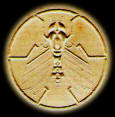 of Les Mouches, called Crisco's that got a completely racially mixed crowd and stayed
open till dawn. (This was not the same place as the Crisco Disco.) I
was hitting the Anvil and 12 West, and when Les Mouches opened I had an entrιe
and went there once in a blue moon. But you didn't really have to go to a disco to
hear the music, and I did know people who loved the sound but virtually never
went.
of Les Mouches, called Crisco's that got a completely racially mixed crowd and stayed
open till dawn. (This was not the same place as the Crisco Disco.) I
was hitting the Anvil and 12 West, and when Les Mouches opened I had an entrιe
and went there once in a blue moon. But you didn't really have to go to a disco to
hear the music, and I did know people who loved the sound but virtually never
went.
Les Mouches fly logo (the club was named after the Jean-Paul Sartre play, Les Mouches/The Flies)
Many, many years prior to this there has been a cartoon in the New Yorker magazine showing two women leaving a movie theatre. One was saying to the other, "You know, that's what's wrong with life. No background music." But by the latter half of the Seventies this was no longer the case. Not only did gay bars play never-ending dance music, every gay retail establishment and many straight ones, too, played dance tapes from opening to closing. Perhaps the most obvious characteristic of a gay lifestyle was this sound and its inescapable presence in any gay milieu. The sound of dance music was everywhere that there were gay men.
It is tempting to say that "everyone" did this, or "everyone" did that, which would be a gross exaggeration, of course. However, what can be said is that the presence of a certain gay music/dance culture became so predominant during this period that many gay men in New York, most of whom did not participate in the thick of it, nevertheless considered themselves a part of it even if they were only "passive" consumers and those who were disinclined to even this often exhibited a truculent defensiveness on the subject.
CLONE, SHMONE
Gay
men, since the the attenuation of the Peacock Revolution toward the mid-Seventies, were falling back on conventional American working class clothes
and middle class
"weekend" garb. My own wardrobe had already become Levis,
usually with a non-descript pullover shirt or T-shirt.
(I never succumbed to purchasing La Coste shirts, though, even when they were the rage I didn't like wearing a logo. However, I did have a collection of three bowling shirts from a retro store, which I enjoyed wearing as they had the names of Protestant church bowling teams stitched across their backs.)
My recollection of how guys were dressing in the bars by this time is that most were in Levis and, except for La Costes and Izods, which were something of a uniform for a time, shirts ranged from tees and pullover styles in the summer to sweatshirts, flannel button shirts, etc. in cold weather. However, I do remember that when I went to Les Mouches (a new disco) just after the mid-Seventies that some guys were wearing bellbottoms and there were plenty of flashy mod-style shirts around, and, again, early photos of Studio 54 from the same year show some men in similar clothes. I've seen a photo of the much more down-scale Crisco Disco in its early days, and the two dancers in it are wearing modish clothes too. But I really can't recall seeing those peacock fashions around in everyday life by this time. By the time John Travolta got around to donning his flashy disco drag in Saturday Night Fever, that stuff was sliding off the map in my gay world.
In these same years there was a widespread movement in the mainstream work and social worlds toward allowing very casual clothes into what had been more formal environments...all of which brings us to those fabled creatures of story and queer academia, the "gay clones."
The once humorous gibe "clone" has acquired a lot of baggage over the years. In later years the reference to "gay clones" became a pejorative label, an accepted shorthand for demonizing an entire generation of gay men. This has came about as the result of the AIDS epidemic, during which public hysteria attempted to fix the blame for the HIV retrovirus onto gay men which resulted in a desperate reaction on the part of some gay men to redirect it onto a particular subgroup of gay men.
A loony and pathetic free-for-all ensued: either all (or at least most) gay men were these dissolute and disease-bearing "gay clones," or if you were a gay man on the defense you could draw some squiggly line in the sand and then identify only the guys on the other side of it as those pestilence bearing "gay clones." Thus, in the culture wars of the 1980's the so-called "gay clone" took on Godzilla-like proportions and inclinations. And this type of is/is-not huffing and puffing continued into the 1990's, providing grist for the mills in the struggle between straight conservatives and those younger post-AIDS queers with their own conservative assimilationist agenda. To straight conservatives "gay clones" were still the barbarian at the gate; whereas the gay assimilationists felt anxiously obliged to pronounce that same evil tribe extinct as they sought admission to the Promised Land of the het-breeder.
The term "gay clones" is truly confusing. How often do we hear of "non-clone gays"? Or "non-gay clones"? Is there a checklist one can refer to? Who's on first....?
I'm not about to plunge onto the battle ground of past culture wars, or the even more recent Queer wars, in search of a definition. Merriam-Webster will have to do. After dealing with the scientific aspect of "clone," M-W gives us this , 2 : one that appears to be a copy of an original form : DUPLICATE.
Perhaps we've found the shallow end of the pool. My own first exposure to the term "clone" was in reference to the style of dress of guys who gathered on Christopher Street in the late 70's. Like how do you find your roommate in a flannel shirt in a crowd of seventy-five men wearing flannel shirts? Not insignificantly the term was simply "clone" as I first remember it being used by gay men.
Jerry Lee Lewis once sang that there was "a whole lot of shakin' goin' on." It doesn't take much effort to see that there's been a whole lot clonin' going' on as well. The 40's Bobby Soxer was certainly a "clone." Check 'em out here. Straight juvenile gangs did/do make clones of their members. And on it goes. There have always been "clones" of one sort or another in straight life and in gay life too, of course.
"Clones" in gay male life were not a 1970's invention, as I can give first-hand witness. Nothing could have been more clone-like in appearance and even in lifestyle than the Ivy League gays of the late Fifties and early Sixties. They (which is to say "we," for a brief while) looked like muffins popped out of a pan, standing around in the bars on the Upper East Side or down in the Village ("picking the lint off each other's sweaters" as one straight woman remarked), or cruising the streets dressed in button-down shirts, "heather-tone" Shetland sweaters, chino pants and penny loafers and dividing their time amongst boozing, blow-jobbing and bitchery (with an occasional breather for Judy worship, of course)...ΰ la Boys in the Band. These lads copy-catting the upper crust Ivy League, staking out theatre, opera, ageing movie stars, etc. etc. as their special territory, and constituting themselves a kind of sophisticated, slightly dandified, in-the-know cabal above the common herd of straight men existed in enough similarity and abundance to have been cloned, of that I can assure you.
But that older "clone" lifestyle does not seem to excite the interest (nor provoke the discomfort) of gay academics in the way that "gay clones" of the late Seventies and Eighties do. I find this odd, as even to me that late Fifties world now seems almost as exotic as that of Louis XIV's painted courtiers. The influence of feminism (or of some feminist thought) may account for this. Gay academics of both sexes are deeply in the debt of feminism, and much in the macho drift of gay male life in the 70's is repellent to it, whereas the late 50's/early 60's present less disturbing gay male images.
Yes, sometimes the clothing in the late 70's and after could be over-the-top, and some of the macho posturing was just plain silly...almost an inversion of the limp-wristed "Get you, Mary!" posturing of the Fifties. But having endured the effeminacy and corrosive bitchiness which was so prevalent in the late 50's and early 60's, I found the change of atmosphere in gay male life (that happened along with the change in wardrobe) during the Seventies and Eighties a welcomed relief. But the bottom line for me was that if the clothes played tough, gay men themselves just plain seemed to behave much more decently toward each other than in the late Fifties.
In any case, gay "clones" abound in type. Leathermen "clones" have also been popped out of their own muffin pan going back to the early Fifties, at least. And to these one must surely add the drag queen "clone." Or in more recent years the queers in turned-around baseball caps, shirts five sizes too large and droopy pants sliding off their hips. Queer "clones," surely.
The popular bomber jacket from the 70's
 I think many people who find the style that emerged after the
decline of Mod/Hippie
fashions especially significant are simply unaware of how prevalent some of these
dress elements already were across a wide spectrum of American
society. "Dungarees," and later the heavier weight blue denim jeans,
had been standard gear for teenagers, working class men and small town adults
since post-WW II. The advent of fashionable bellbottom jeans may have eased
denim's way into acceptability in many
other social
scenes. Gay men after a brief struggle between Wranglers and Levis
came down on the
side of Levi 501's as the one and only jean, of course. But by the latter
part of the 70's straight women and some straight men had abandoned these
brands for the "high fashion" jeans of Jordache, Calvin Klein, etc.
The flannel
shirt had acquired a button-down collar and gone to college with no problem
in the Fifties, and the only difference between the small town high school
kid's flannel shirt and that of the suburban reared college student had been the
quality of the fabric. This gear was already hanging in the
closet, and traditional jeans had certainly not been unknown gay bar apparel,
e.g. the long gone Big Dollar on Third Ave. just much, much less popular during the Ivy League and Peacock eras than they were to become in the Seventies.
I think many people who find the style that emerged after the
decline of Mod/Hippie
fashions especially significant are simply unaware of how prevalent some of these
dress elements already were across a wide spectrum of American
society. "Dungarees," and later the heavier weight blue denim jeans,
had been standard gear for teenagers, working class men and small town adults
since post-WW II. The advent of fashionable bellbottom jeans may have eased
denim's way into acceptability in many
other social
scenes. Gay men after a brief struggle between Wranglers and Levis
came down on the
side of Levi 501's as the one and only jean, of course. But by the latter
part of the 70's straight women and some straight men had abandoned these
brands for the "high fashion" jeans of Jordache, Calvin Klein, etc.
The flannel
shirt had acquired a button-down collar and gone to college with no problem
in the Fifties, and the only difference between the small town high school
kid's flannel shirt and that of the suburban reared college student had been the
quality of the fabric. This gear was already hanging in the
closet, and traditional jeans had certainly not been unknown gay bar apparel,
e.g. the long gone Big Dollar on Third Ave. just much, much less popular during the Ivy League and Peacock eras than they were to become in the Seventies. 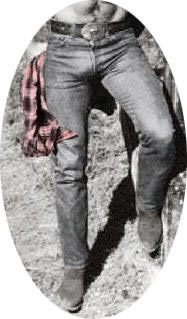
When I went to work in the new computer center of the City University in 1973, the large majority of the male programmers were New York born and bred straight Jewish guys and most of them were dressed in jeans and flannel shirts, and many had moustaches. And this was way too early, and a highly unlikely group of people, to attribute their style of dress to the influence of "gay clones." These straight guys from City College and Columbia University, had they consciously decided to butch it up and copy the Con Ed ditch digger? I don't think so. A lot of guys regardless of sexual orientation were simply grateful to be able to dress down at last. So, on one level the change in dress was a "guy thing."
However, I am inclined to believe that once the constraints on gay life had begun to loosen that some gay men did not feel motivated to cultivate (or preserve) lifestyles that had marked them as apart from, and more "special" than straight men. (Was it really necessary any longer to have seen every movie Ann Sheridan ever made?) Many gay men were not only changing their style of dress with the times, but were moving into activities, e.g. sports and recreations, that they had previously felt (and were told) were the province of straight men. As with other oppressed minorities, new found freedom probably did bring with it a certain amount of exaggerated behaviour which compensated for an underlying uncertainty and resentment.
 With
this dress-down trend underway, some gay men
certainly did make sartorial forays
into flamboyantly hyper-macho territory hard hats, cowboy gear, police and
military uniforms, etc.
and leather had become more common, if not
commonplace, outside the world of leather bars. (But the black leather
jacket even made a bit of a dent in the straight, non-biker market too.)
With
this dress-down trend underway, some gay men
certainly did make sartorial forays
into flamboyantly hyper-macho territory hard hats, cowboy gear, police and
military uniforms, etc.
and leather had become more common, if not
commonplace, outside the world of leather bars. (But the black leather
jacket even made a bit of a dent in the straight, non-biker market too.)
Wearing cock rings during sex was not unusual by this point, and they were sometimes displayed by a few guys, hanging from a jacket epaulet. Keys dangling from a right or left side belt loop indicated passive or active sex role preferences for those into advertising, and a minority utilized a complicated code of colored hankies, worn in either the right or left side rear pocket, which signaled very precisely what type of sex act you found most interesting and whether you were active or passive at it. For New Yorkers, versed as they were in the one-from-column-A-one-from-column-B Chinese menues , this was easily accommodated
And then there are other, more provocative characteristics that are attributed to the "gay clone" unconventional sexual practices, promiscuous sex, and all that there titillating stuff. With this we have now moved into the land of the "gay clone lifestyle." And that is, of course, really what all the controversy is about.
However, this was territory was explored by many gay guys in the city, regardless of clothing style, haircut, neighborhood, favorite hangouts, etc.
My
experience was that if you wanted to find a place where the majority of
the gay men might be uniformed as fully kitted out "clones"
jeans, flannel
shirt...plus leather jacket, keys, colored hankies, cock rings, etc....the whole nine yards
in one package; then we're talking Christopher and West Streets, and the Eagle
and the Spike. But a couple of streets and a bunch of bars were not the
extent of gay New York, nor the majority of its gay men. Outside of these
touristic hot spots guys in other neighborhoods were far less likely to look
like they were dressed by a cookie cutter. What about the guy in Levis and a plain white tee shirt
was he a "clone?"
If fisting was in his sexual repertoire, does a guy then become a "clone." What if
a guy doesn't get fisted, but he changes into a flannel shirt and sports a bunch of
keys hanging from his belt
is he in the game? What about in shorts and a
tank top, with a colored hanky in his back pocket?
What about the guy in Levis and a plain white tee shirt
was he a "clone?"
If fisting was in his sexual repertoire, does a guy then become a "clone." What if
a guy doesn't get fisted, but he changes into a flannel shirt and sports a bunch of
keys hanging from his belt
is he in the game? What about in shorts and a
tank top, with a colored hanky in his back pocket?
The array of dress, habits and attitudes which have been cobbled together under the term "gay clone" seems remarkably and meaninglessly multifarious. In fact, the term "gay clone" is as omnivorous as The Eggplant That Ate Chicago. Like the assessment of beauty, it is heavily dependent on the eye or in this case, I think the agenda of the beholder.
Clone, shmone.
And at the end of the day, what is the fashion industry, but a clone-creation enterprise? And Women's Wear Daily and Gentlemen's Quarterly its-how-to manuals.
A friend of mine once remarked with sarcastic emphasis that gay life became less "precious" in the Seventies a comment that's not a bad snapshot of the era. In any case, Saturday night costuming and partying on Christopher Street or in a leather bar in west Chelsea wasn't the measure of the New York gay male. A more shocking truth, though one rarely even alluded to because it is excruciatingly unsensational especially when compared to something like fist-fucking in a sling at the Mineshaft, for example is that gay men in the city, the same ones who <gasp> wore flannel shirts and jeans, used drugs, and did God knows what in the sack with their dicks and assholes, also got up in the morning, made coffee, showed up for work...paid the rent, and the telephone and utility bills, and were self-sufficient, dependable friends and as time would prove incredibly strong and resilient human beings when the chips were down.
It may have been the era of the Juicy Life, but most guys didn't quit their day jobs to enjoy it. Even in New York.
And we should consider every day lost on which we have not danced at least once.
Friedrich Nietzsche
My own musical memories of these years are of a great sense of fun and exuberance on the dance floor. And often there was joy, unspeakable joy, in the room.
Just some of my top-of-the-head stuff:
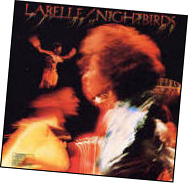 Something as hokey as
Car Wash ('74) from a no-content film, or Joe Tex's
Ain't Gonna Bump No More ('77) could light me up. Love Hangover
by Diana Ross ('76), Dancing Queen by ABBA ('76), Lady Marmalade
by Labelle ('75) or Peaches and Herb's, Shake Your Groove Thing ('78),
Shalamar's Take That to the Bank ('78)...Shame, Shame, Shame
('75)
by Shirley & Company come to mind immediately. To this day,
I still say, "Thank you, Shirley and
Company" for the fun.
Something as hokey as
Car Wash ('74) from a no-content film, or Joe Tex's
Ain't Gonna Bump No More ('77) could light me up. Love Hangover
by Diana Ross ('76), Dancing Queen by ABBA ('76), Lady Marmalade
by Labelle ('75) or Peaches and Herb's, Shake Your Groove Thing ('78),
Shalamar's Take That to the Bank ('78)...Shame, Shame, Shame
('75)
by Shirley & Company come to mind immediately. To this day,
I still say, "Thank you, Shirley and
Company" for the fun.
(above) Nightbirds album by LaBelle
 Dr. Buzzard's Original Savannah Band ,1976,
with vocalist Cory Daye, was one of the greatest albums of the era it always
reminds me of Les Mouches. Thelma Houston sang her great Don't Leave Me
This Way in 1976 too. In early November '76 the
Newsweek cover story on "discomania" appeared. And the music kept
coming on
Best of My Love
by a terrific group, the Emotions ('77)
a favorite of my friend, Charlie
Collins, and Native New Yorker
still the city's signature song for
some, by Odyssey ('77). A friend and I celebrated New Years Eve '77/'78
along with hundreds of other guys
at Les Mouches, the glitzy new disco and
club. 1978 saw the hits Shame, Evelyn Champagne King;
If My Friends Could
See Me Now, Linda Clifford; Fire by the dynamite Pointer
Sisters, whose San Francisco Opera House concert album is smashing entertainment even
today. (It was finally reissued on CD. It is one of
the greatest concert albums ever.)
Dr. Buzzard's Original Savannah Band ,1976,
with vocalist Cory Daye, was one of the greatest albums of the era it always
reminds me of Les Mouches. Thelma Houston sang her great Don't Leave Me
This Way in 1976 too. In early November '76 the
Newsweek cover story on "discomania" appeared. And the music kept
coming on
Best of My Love
by a terrific group, the Emotions ('77)
a favorite of my friend, Charlie
Collins, and Native New Yorker
still the city's signature song for
some, by Odyssey ('77). A friend and I celebrated New Years Eve '77/'78
along with hundreds of other guys
at Les Mouches, the glitzy new disco and
club. 1978 saw the hits Shame, Evelyn Champagne King;
If My Friends Could
See Me Now, Linda Clifford; Fire by the dynamite Pointer
Sisters, whose San Francisco Opera House concert album is smashing entertainment even
today. (It was finally reissued on CD. It is one of
the greatest concert albums ever.)
Found a Cure by Ashford and Simpson ('79) may have been the first song I ever fell in love with it could have been a guy I was so hot for it!
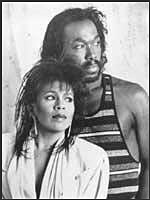
Found a cure
Ooh for your heartache
Before you wake
Before you wake
Don't take no medicine
Take a little of this
It worked for me
And it can't miss
Found a cure
Oh try it
music & lyrics: Ashford & Simpson
And Gloria Gaynor's anthem, I Will Survive in 1978.
During the earlier part of these years much of the dance music and its lyrics ran a gamut from just plain upbeat fun to a fairly tame sensuality and what I remember most joy! Toward the end of the decade the music at least in the hands of some DJ's took on a harder, more edgy tone, and then with the arrival of Hi NRG music and the introduction of some danceable rock music (e.g.,Bruce Springsteen's, Dancing in the Dark) there was a broad change in dance music.
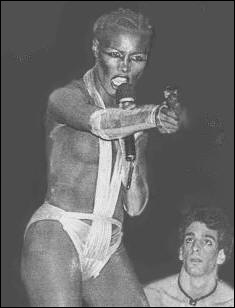 In
many respects gay life, as acknowledged in the Newsweek article, was
channeling the black ghetto to straight white America, and giving it some tweaks
of its own.
In
many respects gay life, as acknowledged in the Newsweek article, was
channeling the black ghetto to straight white America, and giving it some tweaks
of its own.
Grace Jones (and spellbound fan.)
By this point many straight people were venturing into gay discos as the best places in the city to dance to new music and be in on whatever was trendy. I remember being disappointed at the number of straight people who showed up at Les Mouches. (That club's lawyer was the infamous Roy Cohn, by the way.) I was not the only gay man who felt this way, and I preferred as did others not to have to mix with straights on the weekends, unless I chose to. Straights still called too many shots in the lives of gay people for me to want to give them my weekends too.
Studio 54, opened in 1977 and it had a crowd which mixed straight and gay people. Disco become a brief craze with straights and more straight discos opened. The movie Saturday Night Fever capitalized on the disco mania and two of its songs became hits, Staying Alive and Night Fever. I didn't catch up with it until sometime in the 90's, when I rented the video it was, after all, a film about them and their clubs, not us.
The straight disco dance scene had a brief staying power, and then fizzled out in a burst of homophobia. While the new dance phenomenon was heralded as being a nationwide obsession, it drew its talent and vitality (artists, club and radio DJ's and recording technicians and dancing aficionados) from the black and gay subcultures. These were concentrated most heavily in the cities of the East and West coasts and in the so-called Middle Coast area. In these areas the dance music scene was far more creatively volatile and abundant than elsewhere.
Soul Makossa by Cameroonian Manu Dibango, one of the first
songs discovered in a gay club by WBLS's Frankie Crocker.
Its fans were not just spectators as was the case with rock, the dancers were performers, and their input was not limited to point-of-sale purchases of a finished product. Club DJ΄s would play anything from any source (big, small or unknown) that they thought would move their dancers, and the dancers' response in the clubs kept the pot boiling with music that sometimes never made it high on the music industry disco charts. Record producers distributed new releases to club DJ's. Radio station managers and radio DJ's roamed the clubs eager to pick up on the latest unmarketed/unpromoted music, and gay clubs were the major part of their circuit. This synergism in the Coastal cities kept gay and black urban dance venues infused with new music, much of which never reached the white suburbs, much less the hinterlands. In the "out there" straight white discos, and often their DJ's, were unconnected to, and antipathetic to the gay and black subcultures; and at their worst pumped out a kind of Top 40 style disco combined with mainstream disco novelty items. Even gay discos in those same areas were not necessarily on a conduit from the cities, and comments on Net disco nostalgia sites show that even out-of-town gay men were sometimes astounded at the music they heard when visiting dance places in New York, San Francisco, etc.
EVERARD BATHS FIRE
May 25, 1977 the almost century-old Everard Baths at West 28th near Broadway caught fire, a day before a fire sprinkler system was due to be put into operation. Nine men died, seven were seriously injured.
One of the dead was Jimmy Stuard, the immensely well-liked young DJ at 12 West.
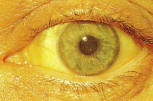 In
1978 I contracted a very serious case of hepatitis B from blood transfusions
after corrective surgery to my previous operation of '75. Not being able
to drink alcohol during the post-recovery months proved impossibly difficult. Though I never drank at
home (and Tom, my roommate did not drink at all) I did drink whenever I went out
and I often went out just to drink. Alcohol had been an part of life since
we sneaked out to booze illegally as teenagers. Since college
drinking
had played an ever-inceasingly destructive part in my life,
and it went from being liquid courage to poison. Over the years I'd lost
jobs because of it, became a nasty and hostile drunk and the physical and mental
aftermath of drunken nights became more and more devastasting...the whole nine
yards of alcoholic drinking. And, thus, the predictable return to boozing
far too soon after the acute phase of hep B subsided.
In
1978 I contracted a very serious case of hepatitis B from blood transfusions
after corrective surgery to my previous operation of '75. Not being able
to drink alcohol during the post-recovery months proved impossibly difficult. Though I never drank at
home (and Tom, my roommate did not drink at all) I did drink whenever I went out
and I often went out just to drink. Alcohol had been an part of life since
we sneaked out to booze illegally as teenagers. Since college
drinking
had played an ever-inceasingly destructive part in my life,
and it went from being liquid courage to poison. Over the years I'd lost
jobs because of it, became a nasty and hostile drunk and the physical and mental
aftermath of drunken nights became more and more devastasting...the whole nine
yards of alcoholic drinking. And, thus, the predictable return to boozing
far too soon after the acute phase of hep B subsided.
After a booze session that left me sick for three days I attended my first AA meeting. I discovered that in Manhattan, at least, the organization was totally accepting of gay people. There were some groups that had a large gay attendance, or were almost totally gay and several of these were on the Upper West Side. The Chelsea-Riverside AA group in these years met in the smoke-filled basement of St. Stephens Church on Friday (or was it Saturday) nights and was a mind-boggling blend of Harlemites, gay men, yuppies and one-of-a-kinds. It was diplomatically characterized as being a "rough edged" meeting. And indeed it was. The atmosphere veered erratically in style from revival meeting to group therapy session to outer space, and as I said to a friend, while there was no boozing it could hold its own against any bar I'd ever been in. Gay guys were always found among the elected positions in the Chelsea-Riverside group. There were other far more sedate AA meetings on the Upper West Side in the late Seventies (e.g. Rutgers, Hargreave, Collegiate, etc.) where gay men and lesbians attended and were active in leaderships positions. Not surprisingly, in the Village several gay meetings existed.
I never drank alcohol again after I attended my first AA meeting.
A side effect of my medical/booze crisis was that I became aware that a surprising number of guys, though not a large one, drank mugs of soft drinks or wine spritzers in the bars. As in my case, some were probably not drinking alcohol because of health or abuse problems, but the use of drugs also had something to do with it. Grass (and other drugs) often raised a fierce thirst, and if you were slugging down beer or liquor to quench it, you could end up drunk very fast thus ruining the high, as well as producing a very negative impact on sexual performance. "No thanks, not when I smoke," wasn't an unusual refusal when you were buying a round of beers for a group of friends.
What had been noticeable to me, even before I stopped drinking, was that the general level of over-drinking/drunkenness in gay bars seemed to me to have become less than what I remembered from the late Fifties and Sixties. And the overall level of sociability seemed to have improved. The bars still got their occasional "problem drinkers" in an evening, but hard core alcoholics were more a regular feature of daytime business, including those guys who rushed to a bar immediately after work every day and then staggered home just about the time the usual evening business began to pick up. I went out socially with a gay co-worker a few times after I was not drinking, and he and his clique of friends followed this routine almost daily.
The
immediate post-op/hepatitis recovery period had induced a reading binge. I knocked off
three gay books published in 1978, each was brought out by a mainstream
publishing house: Edmund White's Nocturnes for the King of Naples
was a short, elegiac, novel which White once said was the favorite of
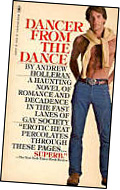 his
works. [I re-read Nocturnes several decades later, and thought most
of it was embarrassingly purple.]
his
works. [I re-read Nocturnes several decades later, and thought most
of it was embarrassingly purple.]
(right) Dancer from the Dance 1979 paperback cover
Dancer from the Dance, was another, and was Andrew Holleran's debut. It was the auspicious beginning to a series of fine books that are like a modern reworking of the ancient Irish story of Oisνn's sojourn in Tir na nΣg, the Land of Youth, and his fate when he returns to the everyday world. (The fatal blaze at the Everard Baths in May '77 figures in the novel.) The last which I had to give up on even though I'd made it three-quarters of the way through was Faggots. This was written by Larry Kramer (Academy Award nomination for the script of Women in Love) on the heels of a disappointed love affair, according to an interview with him in the April 6, 1998 New York magazine, and it does have the very distinct flavor of sour grapes. But mainly it desperately cries out for serious editing, and a better sense of humor. The latter, in my estimation, marred everything that Kramer ever did.
My first year in AA I stayed out of bars. My life was really coming together, and quite surprising to myself, I pulled an iron will out of a hat and resisted every urge to drop into my local bar. A benefit of this otherwise rigorous interlude was discovering the all-classical music station WNCN. I found staying home on weekend nights during my recovery period and listening to WBLS's dance music drove me up the walls! Lemme out! lemme out! I'd not had much previous interest in what is called "serious" music, i.e. classical. You could have put my pedestrian collection of classical LP's in a shirt box and still had room for the shirt. But what I'd expected to find boring, but hopefully tranquilizing, turned out to be fascinating. In a matter of weeks my pure disco soul was being dragged from Alkan to Zemlinsky and back again, though admittedly toking on some dynamite grass did help to get me to the farther shores of Monteverdi's madrigals and some of Penderecki and those Bartok quartets! Is it possible he was blowin' grass?
 Admittedly, one memorable
evening in 1976 had already given me a strongly positive
attitude toward the classical music experience. Van, my hunky and
unfailingly good-natured, Columbia grad
student friend and I began having sex while Mahler's "Resurrection" Symphony
was playing on the stereo. Van was a dedicated in-for-the-distance jogger,
and he brought the same sustained energy to screwing. We reached a mutual climax during that passionate vocal plea, "Glaube,
glaube...." How do you tell people Mahler's Second Symphony is "our
song"?
Admittedly, one memorable
evening in 1976 had already given me a strongly positive
attitude toward the classical music experience. Van, my hunky and
unfailingly good-natured, Columbia grad
student friend and I began having sex while Mahler's "Resurrection" Symphony
was playing on the stereo. Van was a dedicated in-for-the-distance jogger,
and he brought the same sustained energy to screwing. We reached a mutual climax during that passionate vocal plea, "Glaube,
glaube...." How do you tell people Mahler's Second Symphony is "our
song"?
"Listen, they're playing our song."
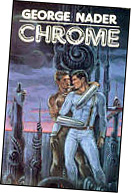 Gay
movie actor, George Nader (a childhood lust object of mine from Loretta Young's
TV show) wrote a sci-fi novel, Chrome, which I had to read on Chuck-the-Plantman's
orders or kiss off our friendship. I read it, I liked it.
Gay
movie actor, George Nader (a childhood lust object of mine from Loretta Young's
TV show) wrote a sci-fi novel, Chrome, which I had to read on Chuck-the-Plantman's
orders or kiss off our friendship. I read it, I liked it.
(Cover of George Nader's novel.
I also read my first Flann O'Brien novel, At-Swim Two Birds. It was remarkable, to say the least, and I went on to The Third Policeman and others of his, which is how I became acquainted with the early scientist, DeSelby, and his largely unrecognized work on darkness as an accretion of 'black air'. (Almost as mind-blowing as the use of Mom's Crisco as a sexual lubricant). Also on the bookshelf in the last half of the decade were the collected poems of the lesbian poet, Elizabeth Bishop given to me as a birthday present by a gay friend at the Computer Center, and Cavafy, a book by Robert Liddell on the life and work of the gay Greek poet, whom I'd first been introduced to by a gay workmate when I was working at Fairfield Reading. During the same years I took a six-week seminar at the Jung Institute, a lecture series at the Met in connection with the Irish Gold show, and a course in Irish Gaelic. And at the seminars, the lecture series and yes, even, at the very conservative Gaelic Society, I saw that we are, indeed, everywhere.
Chuck and I also saw a production in the Village in early '78 of two modern Noh plays by the gay Japanese writer, Yukio Mishima. The next fall was Bent, starring Richard Gere and David Dukes as two lovers in a Nazi concentration camp, at the new Apollo Theater on West 42nd Street part of a brief attempt to bring legit theater back to the Duece.
So, contrary to what the musical had said, maybe life was not always just a cabaret.
PLAYLAND: THE ANVIL, 12 WEST, FLAMINGO and THE MINESHAFT
In Greenwich Village most of the bars, restaurants and shops for gay men were clustered along Christopher Street and ran down to the river and the pier at its western end. Running north on the waterfront blocks were more were more bars and shops, which encompassed an area of dilapidated old warehouses and the meat-cutting plants of the Washington Market. At 14th Street, the northern boundary of the Village, the character of the area changed abruptly. The street from Ninth Avenue to the Hudson was a hustling strip for drags with the Anvil located at the river end, and north of here were two famous leather bars, the Eagle and the Spike, near the waterfront in Chelsea. In this northwestern area were a scattering of bars and "clubs", places with names like the Zoo, the Underground, Alex in Wonderland and others, some of which served alcohol after hours and many had "backrooms", i.e. rooms for sex. In the second half of the Seventies there were three places in this area I visited for awhile.
The
Anvil opened in September 1974 and was the northern Village outpost of this
area. (It closed in November 1985.) Early on it was a simply a very sleazy
bar that sold alcohol after legal closing hours till dawn, and which had a tiny
dance floor and a far from terrific juke box. It was on the ground floor
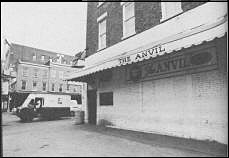 of a small building, the upstairs of which was a rundown hotel where
some drag queens
lived. However, the later addition of drag acts, a sex show, a professional DJ and a
back room revved up the entertainment level considerably.
of a small building, the upstairs of which was a rundown hotel where
some drag queens
lived. However, the later addition of drag acts, a sex show, a professional DJ and a
back room revved up the entertainment level considerably.
The Anvil
The Anvil was one of the few places in this era, in my experience, which regularly featured drag acts as entertainment. The mix of customers was beyond imagination: some squeaky clean types, leather men, guys who drifted over from the Christopher Street bars a mix of ages, ethnicities and races, plus in its later years, pickpockets and assorted troublemakers.
For awhile in its early days the Anvil acquired a notoriety that drew bored members of the Rich and Famous set looking for a place to do some new slumming shades of Cabaret! (Truman Capote and Princess Radziwill, Jackie Onassis' sister were reputed early visitors, which sounds about right they were both skeevy celebrity types.) The after-hours atmosphere of the Anvil was rather wound up and frantic from the amount of alcohol and drugs its patrons had already consumed before arriving, and they were intent on consuming more. The drag performers often looked like revenants when they walked through the crowd they were so zonked. But their stage performances ran to the other extreme: exaggerated lip synching, bug-eyed grimaces and arms flung out in one histrionic pose after another. If you can visualize a jumped-up version of the last scene of Poulenc's Dialogue of the Carmelites one done by a flock of marabou who've just mainlined amphetamine, and each in turn ascending the stairs to have a fit instead of kneeling for the guillotine then you have the picture: serial drag diva hysteria. Shit, it was mezmerizing!!! A few times there was an a nervously giddy, anorexic looking guy in a G-string riding a swing over the bar.
I went the there the first four years or so, and rather liked it. I stopped going downtown in the early spring of '79, however; I heard later on that the backroom of the Anvil became the scene not only of rampant pickpocketing, but of at least a two of stabbings as well. (A couple of web sites remark on the wonderful drag acts at the Anvil, and how sexy the bar performers were. Well, that definitely wasn't the case when I was going there drugs always seemed to have taken their toll on the performers, but it's possible these acts changed for the better after early '79 when I stopped going there.)
I also went down to a new club, the Paradise Garage, a few times when it was just opening., but I preferred 12 West. This was in the "Gray Room" era of the Garage, I guess. The Garage quickly became predominantly black and Latino I understood, though I had a casual friend who was white who would never go dancing anywhere else.
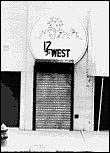 12
West, was a favorite disco for gay men for many years. It was in a shabby
warehouse building but on the inside had been renovated in early '75 so that it rather
resembled a high school gymnasium or at least that's what it reminded me of.
12
West, was a favorite disco for gay men for many years. It was in a shabby
warehouse building but on the inside had been renovated in early '75 so that it rather
resembled a high school gymnasium or at least that's what it reminded me of.
12 West
It had a great dance floor, incredible sound , and was definitely not an attitude factory. There was a mix of guys, not just racially or ethnically, but as far as appearance, dress, income. This was where I first heard DJ Robbie Leslie play.
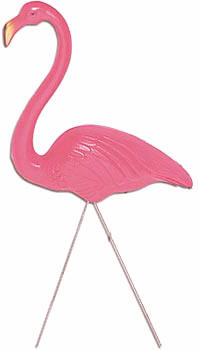 Michael
Fesco, who had whipped the Ice Palace in Cherry Grove into shape, created a
totally different world at Flamingo in 1974. It was across town, at Broadway and Houston, in an area known now as NoHo and was the
hot gay dance club of the last half of the Seventies. While there was little in the way of
impressive lighting
and dιcor, the music was superb Howard Merritt, Richie Rivera. Memberships
practically vanished, until they were selling
black market for five hundred bucks. This was reflected in the
makeup of the crowd
white with almost no blacks, and in a reputation of
drawing its clientel from the Upper East Side and Pines. Of course, in
addition to not being affordable by most ethnic and racial minority gay men, it
wasn't a place that your white working class gay grunt or ribbon clerk could
afford to patronize either. Flamingo was a business, and unlike some elite prep school overflowing with guilt, cash and noblesse oblige, no
scholarships were handed out. Clothes, looks,
body and attitude were everything. Among the regulars were guys like Ari, an
Israeli I knew casually, superbuilt bodybuilders (this is the era just before everyone went to a gym, remember) who became an essential part of the
decor. My attendance was infrequent, my only entree was as the guest of people who knew the owner.
Was I oppressed? Has my life
been permanently blighted because of it? Is there someone I can sue?
Michael
Fesco, who had whipped the Ice Palace in Cherry Grove into shape, created a
totally different world at Flamingo in 1974. It was across town, at Broadway and Houston, in an area known now as NoHo and was the
hot gay dance club of the last half of the Seventies. While there was little in the way of
impressive lighting
and dιcor, the music was superb Howard Merritt, Richie Rivera. Memberships
practically vanished, until they were selling
black market for five hundred bucks. This was reflected in the
makeup of the crowd
white with almost no blacks, and in a reputation of
drawing its clientel from the Upper East Side and Pines. Of course, in
addition to not being affordable by most ethnic and racial minority gay men, it
wasn't a place that your white working class gay grunt or ribbon clerk could
afford to patronize either. Flamingo was a business, and unlike some elite prep school overflowing with guilt, cash and noblesse oblige, no
scholarships were handed out. Clothes, looks,
body and attitude were everything. Among the regulars were guys like Ari, an
Israeli I knew casually, superbuilt bodybuilders (this is the era just before everyone went to a gym, remember) who became an essential part of the
decor. My attendance was infrequent, my only entree was as the guest of people who knew the owner.
Was I oppressed? Has my life
been permanently blighted because of it? Is there someone I can sue?
 Flamingo at Broadway & Houston
Flamingo at Broadway & Houston
Flamingo was one end of an axis, the other being the disco at the Sandpiper in the Fire Island Pines. This was so much so, that Flamingo was almost literally the Pines in an urban winter setting. Gay discos made little concession to the seasons. Inside it was always summer at the beach.
In the Pines the Sandpiper closed on Halloween '79. It was torn down and replaced by the Pavilion, an enormous structure which looked like it had been inspired by a packing crate, and it no longer bothered with a restaurant business. (And at last report, the Pavilion was intending to rise like a phoenix from the ashes of a fire that totally destroyed it in late 2011,)
A Village Voice article by Andrew Kopkind described Flamingo:
"The throbbing lights, the engulfing sound, the heightened energy, and the hyperbolic heat of Flamingo gives me the sense (which I have heard others share) that the world is enclosed in this hall, that there is only now, in this place and this time. It can be extraordinarily assaultive. I have felt trapped forever in a theatre of sound, of flesh, like a character in Buρuel's The Exterminating Angel, unable to leave a party even after its positive appeal has fled. But what is worse is the prospect of a chill gray Manhattan dawn outside. Leaving is more depressing than staying: the disco beat is like a life rhythm, and to stop would be to create a killing thrombosis."
What the Mineshaft was compared to the baths, Flamingo was compared to 12 West and other discos so overwhelming that it seemed to be manifesting an occult level of experience.
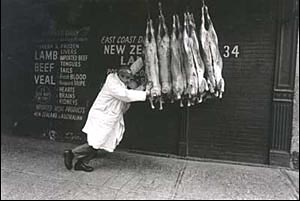
Washington Market 1970's
Later on there were the Guignol mornings, coming home from the Mineshaft or the Anvil or some other after-hours bar near the river in the West Village. The meat packing houses would be open by then. There was often a heavy mist drifting off the river through the streets. Sounds were smothered and fragmented.
Doors rolling open on the big trucks. The clanking machinery. Men's voices. All of it seemed to come at you in pieces from far away.
The pavement was heaved and wet black by the heavy mist, with rivulets and puddles of blood from the carcasses swinging along on hooks into the cutting plants. It wasn't frightening or gory, the carcasses were more like an affront. They swung through the street, suspended from overhead conveyers, twisting and turning, scarlet and white, with a great gash the length of them. They showed their emptiness, silently jeering at you like picked pockets.
Sometimes the workmen stared at you. They knew what was going on in the clubs down there, but it was the empty carcasses swinging by that were reproachful.
from Like the Sun Rushing
Jack FitzGerald
 The Mineshaft on Washington Street
ultimately enjoyed a worldwide reputation. The movie Cruising was shot
around there. It was in a dumpy warehouse building on the West Village waterfront. (I
always thought it had been the site of an illegal after-hours dance place, the
Exile, in the early 70's.) It was an all-night place with the sole purpose of
sex and drugs. The bar area had a juke box full of
current gay favorites, e.g. Ike and Tina Turner's Proud Mary. The Mineshaft
decor made no effort to be slick or attractive, concentrating instead on hard
core sexual
fantasy. The bar area had a small bar, tables to sit on (tables provided major
seating during the 70s no one ever sat at a table, only on one.) And
there was the mandatory pool table, of course. Pool tables cropped up in many
bars during this era and were an obligatory part of the bar decorator's art.
The Mineshaft on Washington Street
ultimately enjoyed a worldwide reputation. The movie Cruising was shot
around there. It was in a dumpy warehouse building on the West Village waterfront. (I
always thought it had been the site of an illegal after-hours dance place, the
Exile, in the early 70's.) It was an all-night place with the sole purpose of
sex and drugs. The bar area had a juke box full of
current gay favorites, e.g. Ike and Tina Turner's Proud Mary. The Mineshaft
decor made no effort to be slick or attractive, concentrating instead on hard
core sexual
fantasy. The bar area had a small bar, tables to sit on (tables provided major
seating during the 70s no one ever sat at a table, only on one.) And
there was the mandatory pool table, of course. Pool tables cropped up in many
bars during this era and were an obligatory part of the bar decorator's art.
Off to one side was an open archway which disappeared into blackness. Once beyond the arch you were into an S&M/sexual fantasy trip. The lighting was minimal, shadowy with only a few dramatic spotlights. There were stalls simulating johns with glory holes cut in the walls; a row of shoeshine chairs mounted on a platform complete with the stanchions for putting your feet on; in the center of this room under a bright spot was a sling and a can of Crisco, there was also a completely empty room lit in blue lights off to one side, a totally dark closet-like room and an alcove with two benches tilted head downwards with cans of Crisco beside them. Below all this was another room with accoutrements for water sports. While everyone arrived clothed, of course, as the hours wore on people drifted in and out of the sex rooms and back into the bar in greater and greater states of undress.......not to mentioned slick with sweat and grease.
The taped music in the sex area was unusual. These tapes did not feature dance music as such, unless the songs were extremely erotic/exotic in orchestration or lyrics. The tapes were an eclectic mix of music and subtly incorporated sounds and voices calculated to accommodate and enhance the drug and sex fantasy atmosphere. I have a copy of one of the last tapes made for the Mineshaft, and it is not music you would want to just sit around and listen to. There is a vaguely discomforting quality about it when you are listening to it stone sober in the bright light of day.
The place was open seven days a week from about 11 p.m. to dawn. Wally, pointed out to me as the manager, was an affable guy who had had a very straight career in advertising in the Sixties, I have been told, before he discovered drugs and kinky sex and also discovered that there was a world waiting to be served from the same menu. The drugs used here were ludes (methaqualone), grass and all sorts of hallucinogens, and, of course, amyl nitrite. Drugs were almost a necessity, I think, if you were going to be able to stand the incredibly intense atmosphere of the place. I was essentially a voyeur. I honestly found it overwhelming, and using drugs inclined me to safely space out and pay more attention to the music than the flesh. To use a totally overworked word appropriately for once it was awesome.
But on those occasions when I did connect with someone, we left for home.
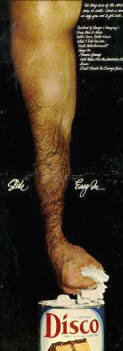 The cover art of pop
poet/singer/composer Rod McKuen's
The cover art of pop
poet/singer/composer Rod McKuen's
disco album of the late 70's, "Slide Easy In." The hairy, muscular arm and
big
fist belong to Bruno, an extremely popular Colt model of the era.
It wasn't all fun and games down in the far West Village. In 1979, Nefty and Nathan, who had opened the Picadilly Pub and been involved in Boot Hill and Wildwood on the Upper West Side, working for Sonny and Jennie Tobin (some of the many bars the Tobins owned over the years), were running gay place down on Hudson St. Early one May morning, after they had closed and locked up the bar (called the Hell something, Hell Fire, maybe), two men cajoled their way in with a phony story. Very quickly Nathan and Nefty, plus the unfortunate young bartender/boyfriend of one of them, became the victims of what Upper West Side scuttlebutt said was a revenge killing. Nefty was kept in the bar area, while the others were confined in two different rooms. Nefty was killed and rumored to have been mutilated as well. Although the night's receipts were missing, none of what occured fit a simple hit-and-run NYC robbery. Next the young bartender was stabbed to death in the room where he'd been locked up: and then Nathan was pulled out of the bathroom where he had been held and shot. The killers fled. Nathan had not died, however, and under police guard in the Roosevelt Hospital, he survived his wounds. What really prompted the slaughter bar business problems, drugs or what was never reported in the newspapers. The crime was never solved. (Incidentally, Sonny Tobin himself had been rubbed out just six months before at his own home in Queens, witnessed by his wife Jennie.)
Nathan later appeared uptown again as a bartender at Boot Hill. He was a simple, uncomplicated guy who everyone had always liked, contrary to Nefty. Guys were happy to see him back in the neighborhood, and as far as I know no one ever pumped him for more info on the events of that night.
THE WINDS OF CHANGE START SHIFTING TO THE RIGHT
Living in Manhattan I found that now I rarely thought about anti-gay sentiment, much less worried about it. Certainly in my part of the Upper West Side I felt totally accepted and at ease wherever I went. Although my new landlady was a smirking, patronizing overt homophobe, she was an even worse asshole if possible about blacks, Jews, etc. etc. And she was an exception in my experience.
Most of the people I knew in these years were not hiding their sexual orientation on the job. Tolerance, if not actual acceptance, was common, though it varied from company to company. The Central Office of the City University, where I worked, fell over backward congratulating itself on its ultra-liberal attitudes and positions; however, these applied to race and ethnicity and did not on paper extend to gay people. While the administrations of the individual 18 campuses were gay tolerant to one degree or another and had openly gay faculty and staff members the Central Office environment seethed with homophobia. Among lower level staff I found that homophobia was very pronounced among many black employees. But later, when I was going to apply for a vacant position at the uptown Central Office location, I was told that although I would be the most qualified applicant, the head honcho of our division would not be comfortable having an out gay person working as his administrative assistant there. There was no use complaining as the Central Office didn't have a non-discrimination policy that included gay people and the "advice" had been given verbally and in private, and would certainly have been denied. (It would not be until the late 80's that the Board of Higher Education and the Central Office of CUNY would include gay rights in its array of ultra-liberal policies well behind the actions that had already been taken by some of the constituent colleges, e.g. Baruch College.)
Fortunately down at the Computer Center on West 57th things were considerably more relaxed. Even though it was administratively part of the Central Office, its location on the other side of town allowed it to develop a different climate. Very early on one clerical employee's transfer from the Central Office to the Computer Center was arranged in part because one of his two bosses was "nervous" about the fact he was gay. Soon after this we got two male clerical workers from a Civil Service employment pool, and both were gay. Without actually calculating to increase that total, I did so more or less by accident. I was in charge of hiring workers for clerical positions, many of which were filled with long term temp employees. In hopes of cutting down the amount of time spent doing interviews, which I disliked because it took so much time away from my regular work, I used to mention the availability of these positions to guys I knew in my neighborhood when I went out. Consequently, almost half of the clerical staff ended up being gay men at times.
While a very few of the Computer Center staff were clearly tight-asses where gay people were concerned and maintained a fastidious reserve, by and large most the staff were friendly and accepting. I can remember on one occasion taking a male office temp on our staff as my date to a party given by one of the administrative staff, and even the more uptight individuals there tried to take it in stride. There was a work-study program at the Computer Center, which drew its participants from one of the community colleges in the City University system. These young students were all from working class white or black backgrounds, which in New York City can be amazing provincial (and conservative) very oriented to their local neighborhoods and their social and ethnic groups in the outer boroughs, and regarding Manhattan and the life there with some uneasiness and even animosity. Since much of the opposition to the gay rights legislation which resulted in its continual defeat in the City Council came from the areas where these people lived, I expected these students to be anti-gay. Wrong. It was the opposite, they were totally able to be at ease and friendly with gay staff members. And, of course, a few of them turned out to be gay themselves.
During my five years working in Computer Center one of my best on-the-job friends was Clyde, a straight black departmental director. My job involved keeping track of the budget which paid for rotating groups of work-study students who trained in his department. So, when unusual needs arose, Clyde and I would have to deal with my boss, or one of the other honchos in the front office. In we would march together and appear together in the doorway of the intended victim. At this point Clyde would always grin, shake his head and announce with glee: "You know it's trouble when you see the fag and the colored boy together at your door!" No one, but no one knew how to deal with that remark, which gave us the lead.
He and I used to go out to dinner on the Upper West Side in a foursome with a straight black woman who was consulting at the Center and my friend Charlie Collins, who frequently worked as a part of our temp staff. This did raise some eyebrows at work. But I realized after awhile from some remarks that it had to do with the fact that Clyde lived a very glamorous lifestyle, numbering Sarah Vaughan among his friends for example, and partying at the Hippopotamus, a very trendy, expensive straight nightclub/disco in those years which drew an upscale and celebrity crowd. (It was a precursor to Studio 54.) His lifestyle constantly aroused the curiosity staff members. What seemed to intrigue people was what Clyde with his designer suits and his beautiful, well-turned out girlfriend could have in common with two guys whose idea of dressing up was a new pair of used Levis. Odd as it may seem, I think style and social class really suggested a more unbridgeable chasm to our co-workers than sexual orientation or race.
Gay people had in cosmopolitan and ultra-liberal Manhattan, especially jumped many barriers since changes had begun in the mid-Sixties. With what seemed to be a secure and burgeoning gay social life, I think most gay people may have felt that in their quotidian lives, at least, they had almost achieved the everyday freedoms they wanted...which is not to say that I or anyone else didn't realize that very real and arbitrary limits existed not far below this surface (my blocked job application being just one example)...plus the lack of equal access to all civil rights.
Ed Koch one of the pro-gay liberal Dems who emerged from the Tammany vs Reform wars of the Sixties was elected Mayor in the fall of 77. His terms as Mayor securely established the liberalizing direction of NYC public policies regarding gay people. A bachelor, Koch was pursued throughout his career by snipers and gossip mongers most of them gay anxious to prove that he was homosexual However fascinating the history of his dick and butt hole might be if known, what was to prove far more important about his life was Koch's moral and ethical steadfastness. In light of the disaster which would engulf America in the near future and the wave of hatred and persecution which it would arouse, New Yorkers had made a far wiser choice in the November '77 election than we could have known at the time.
In the last decade several organizations had been founded to push against
barriers of discrimination and intolerance. By the end of the decade one of my friends used to kid about what he
called "those little envelopes," i.e. fund-raising letters from gay
organizations. They were a prick in the conscience, if not a kick in the butt,
and I felt guilty if I discovered that I had put one aside and came across it
later. The National Gay Task Force had been founded in 1973 by Dr. Howard
Brown, the former NYC health administrator under Lindsay, who came out publicly
after he left office. Lambda Legal was also established in the same year after
a tussle in court. (In the next year the APA (American Psychiatric Association)
voted to remove homosexuality from its list of disorders.) The kick-off benefit
for SAGE (Senior Action in a Gay Environment) occurred in the Pines in '77.
SAGE was the only organization oriented to gay seniors and sought to provide
gay-oriented counseling and events for this age group. In 1980 the Human Rights Campaign
Fund was established. 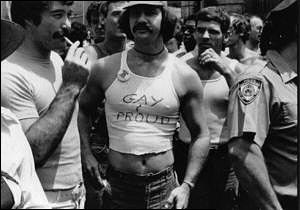
The Gay Pride marches took place at the end of June on Fifth Avenue and drew many thousands of participants and observers and it had grown into a larger and larger event each year.
Spectators at the NYC parade, 70's
Christopher Street from Hudson Street down to the river was closed off as the site of a street carnival. The street was virtually impassable with pedestrians. While most of the organizations in the parade or the street fair didn't interest me, it was a real lift to see how many different kinds of interests gay people had formed clubs and groups for. My friend Chuck Garr was an organizer for a bowling league, so I heard about that non-stop.
I hadn't the slightest doubt, that I wrote down or can recall, but what most major hurdles for gay people would be cleared in my lifetime.
Right Wing possibilities in national life had died with Barry Goldwater
or so I
thought. The Right in my limited knowledge consisted of the remnant of
the 1950's John Birch
Society, Sen. Joe McCarthy's diehard loony believers, Southern segregationists
and the political descendents of Thirties populists and Right Wingers, such as Father
Coughlin and Gerald L.K. Smith. When Sen. Barry Goldwater of Arizona, an A-bomb happy
conservative, received the Republican presidential nomination in '64 I was
flabbergasted. His famous acceptance speech line:
"
Extremism in the
defense of liberty is no vice. And let me remind you also that moderation in the
 pursuit
of justice is no virtue," I was sure would cook his goose. One of the
Republican slogans was, "In your heart you know he's right." Democrats
countered with "In your guts you know he's nuts."
pursuit
of justice is no virtue," I was sure would cook his goose. One of the
Republican slogans was, "In your heart you know he's right." Democrats
countered with "In your guts you know he's nuts."
These and other rhetorical excesses meant that he won only five states in the Deep South, and barely won his home state of Arizona. Many Republican Congressional candidates went down with his ship. It was Goldwater's campaign, however, that resurrected States Rights as a respectable national issue and as something more than verbal camouflage for being pro-segregation.
(It should be noted to balance the picture that Goldwater became increasingly libertarian in his views in his later Congressional career. He was largely opposed to President Reagan, and acquired strong positive views on gay rights.)
And that was that for the Republican Right. Except it wasn't. And I might have realized this by paying more attention to the political activities of one of my maternal cousins from the North, who had moved to the South and become very involved in conservative politics there. He ran for a state office as a Goldwater candidate. He lost too.
Despite President Johnson and the Democrats big win in '64, the Right Wing of the Republican party and ultra-conservatives in general organized meticulously at the grass roots level, and worked and donated to their cause like the people on a mission they were. The liberal wing of Republican party was killed off after the mid-Seventies, and veterans of the Goldwater campaign, such as Ronald Reagan and Phyllis Schlafly emerged among the major players on the Right, along with powerful Christian extremist spokesmen, e.g. Pat Robertson.
The Democratic party lacked cohesiveness and had been unable to find a center after the upheaval of '72.
My first inkling that the Trans-Hudson Outback was on the move came in '77. Dade County (Miami and surrounding area) had passed a gay anti-discrimination law. However, former beauty queen/singer, Anita Bryant, who was also the national spokesperson for the Florida Citrus Commission, started a campaign to have this gay rights legislation overturned in a referendum. Bryant, one of the new style hate-and-fear Evangelical Christians, charged that the ordinance would threaten children with "recruitment" and child molestation. "God puts homosexuals in the same category as murderers," she told her audience. The liberal New York Times, however, rebuked gay people for the tenor of their opposition to her! Executive Editor and major asshole Abe Rosenthal, was still reminding gay people of their place. Had she been aiming her crusade at Jews, one can be sure Abe and the Times would have been talking out of the other side of their mouths. It took the liberal Times a many years to apply their liberalism to gay men and women.
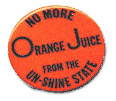
 The
ordinance was successfully overturned by a large majority of the vote. I was
amazed. Never had I dreamed Bryant would succeed in Miami. She then
went on tour, and got a pie in the face in Des Moines.
The
ordinance was successfully overturned by a large majority of the vote. I was
amazed. Never had I dreamed Bryant would succeed in Miami. She then
went on tour, and got a pie in the face in Des Moines.
(right) Gay Des Moines says hello to Anita
But after gay people launched a boycott of Florida orange juice, and she and her husband divorced, the Citrus Commission dropped her. Her singing career was already history, and she and a second husband left a trail of unpaid creditors and employees in their wake as she attempted to rejuvenate her professional life. She finally filed for bankruptcy in two states and went on the lamb from her own Anita Bryant Christian music hall, leaving her hapless Christian employees and supporters without a dime. She and her spouse had piled up huge amounts in unpaid taxes as well; nevertheless, she had been the vanguard of the anti-gay crusade in national politics.
Big name celebrities such as General William Westmoreland, Art Linkletter, Jack LaLanne, Pat Boone and Lawrence Welk had come out in support of her crusade. The Christian ultra-Right now manifested itself on the national political scene as a powerful and respected force and these Christian Rightists and the Republican party each saw their union as a marriage literally made in heaven.
January 23, 1978 Mayor Ed Koch issued Executive Order 50 that barred anti-gay discrimination in any employer who did business with or received funds from the city. This included the R.C. church, which delighted me. Unfortunately Cardinal OConnor successfully sued the city and forced it to rescind the policy. O'Connor was to prove one of the most enduring anti-gay forces in the City, with millions of Catholic lay people in the city following his lead.
In the fall of 1978 the mayor of San Francisco and Harvey Milk, a gay member of the city's Board of Supervisors, were shot to death at City Hall by Dan White, an angry straight supervisor who had just recently resigned after the passage of the city's gay rights legislation. His had been the only "no" vote. At the conclusion of his trial in the spring of '79 the gunman was found guilty of the lesser crime of voluntary manslaughter, not murder. (What!?) This unleashed a wave of violence by gay people, which resulted in a million dollars damage as rioters burned police cars and stormed City Hall in anger. My own reaction to the verdict that it was clearly a miscarriage of justice as White had brought a gun and extra ammunition with him, and contrived to sneak into City Hall to avoid the metal detectors. Manslaughter? Bullshit! Clearly it was premeditated murder.
The verdict was blatant homophobia. This was not exactly a new development. In 1976 teenagers beat a gay college student to death in front of a bar in Tuscon, Arizona the judge, praising their school records, imposed no penalty on them for their butchery! Crimes of violence against gay people often were lightly punished or punished not at all.
 Donna
Summer appeared on the cover of Newsweek in April '79 as part of the
cover story, "Disco Takes Over." Well, yes...but not everyone was happy
about it. Just a year before, in March '78, Rolling Stone had
Summer on their cover and had wanted to know "Is There Life After Disco?"
Donna
Summer appeared on the cover of Newsweek in April '79 as part of the
cover story, "Disco Takes Over." Well, yes...but not everyone was happy
about it. Just a year before, in March '78, Rolling Stone had
Summer on their cover and had wanted to know "Is There Life After Disco?"
Chicago rock DJ Steve Dahl started using the phrase "Disco sucks!" this year,
and it caught on with straight rock fans across the country. In the spring of
'79 I was working at the University's Central Office in the white middle and upper class neighborhood, where Gracie Mansion, the mayor's home is
located. One day I went around the corner to catch a bus and found the shelter
newly marked up with "disco sucks" and anti-gay graffiti. This coupling popped up
everywhere, often accompanied by anti-black slogans too. I never
saw "disco sucks" graffiti that wasn't combined with "hate gays," and other
homophobic scrawls. Not one single time. For the first time
since
 I'd
lived in the city I'm afraid that being gay bashed is a real danger, and not
just a possibility.
I'd
lived in the city I'm afraid that being gay bashed is a real danger, and not
just a possibility.
(right) Steve Dahl's homophobia at the ball game.
In Chicago Dahl promoted a "Disco Demolition Night" on July 12, 1979 between games at a nighttime double-header in Comiskey Park. Listeners were encouraged to bring disco records for destruction. Some observers that night have made a point of saying that lots of the men did not appear to be baseball fans, and many in the crowd started sailing their records like Frisbees onto the field during the first game. At the intermission Dahl came onto the field and detonated a box of records with a charge that ripped a hole in the field, at which point thousands of screwed up straight white Neanderthals charged onto the field fires were started, fist-fighting and vandalism broke out and riot police had to be called in to clear the field. The Chicago team had to forfeit the second game as their opponents refused to take the field, calling the mob conditions unsafe.
"Disco Sucks!" is cited as the end of the disco craze and if one takes the usual myopic straight, white view, it was that. But it is more notable as an eruption of anti-gay and anti-black sentiment among straight whites. Many young white American males clearly felt de-balled by black divas and fags. As a music fad among straights disco died out for this and other reasons but not least because straight white discos and their DJ's had isolated themselves from the black (and gay) wellsprings of dance music. And it had quickly become vanilla pudding...with a few nuts. Thus, for straight whites music went back to being an audience event, standing around watching performers on stage and in moments of outrageous abandon, waving your arms in the air. (Nothing has changed: They just can't handle moving their asses.) The darker significance of this shift could be seen in the epidemic of graffiti which linked anti-disco with anti-gay hate slogans: disco sucks, kill fags was an ubiquitous pairing. You could see it marked on almost every bus shelter and in the subways too. This turn of events, I notice, is almost always whitewashed out in straight discussions of the disco phenomenon on the net.
But dance music and the world of dance clubs continued to thrive among gay men in fact the best dance years in the city hadn't yet happened.
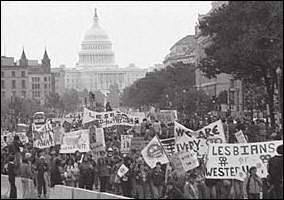 In
October 1979 the first Gay Civil Rights march was held in Washington, D.C.
Though over 100,000 marched it got disappointingly little media coverage.
"Disco Sucks!" may have done almost as well in the mainstream media.
In
October 1979 the first Gay Civil Rights march was held in Washington, D.C.
Though over 100,000 marched it got disappointingly little media coverage.
"Disco Sucks!" may have done almost as well in the mainstream media.
1979 D.C. gay civil rights march
In the fall of 1980 there was a horrible incident which briefly frightened many gay people. One Saturday evening when the gay area at the end of Christopher Street was at its busiest, a car sped down West Street and when it was opposite the Ramrod, one of the most popular gay bars, it opened fire through the windows with a submachine gun! Two men were killed and another six were injured. This was a miracle as the bar was jammed with customers. The assailant, reputedly the son of a preacher, was a lay preacher and a former Transit cop. This was a frightening event, however it did not prove to be the harbinger of a wave of anti-gay gun violence, but was the act of one very tortured man.
Not only did New York gay life not miss a beat, it was accelerating like a rocket. (But at the same time so was the influence of the intensely homophobic Evangelical Christians, and the resistance of the Roman Catholic church hierarchy which was staunchly against any rights for gay men and women.)
Closer to home, just four blocks from my apartment, John Lennon was shot dead in front of the Dakota apartment building, returning home with his wife just before 11 p.m. on the evening of December 8, 1980. Lennon joined the list of famous men publicly murdered in the city. Celebrated architect, Stanford White, had been shot at the ritzy Madison Square Roof Garden by a jealous husband in 1906, and the lurid story has been dramatized several times since. In more recent years Mafia boss, Albert Anastasia had been shot to death in the Park Sheraton Hotel barber shop in 1957; Malcolm X had been assassinated in 1965; in 1971 Mafia biggie, Joe Colombo, was shot at the Italian Unity Rally in Columbus Circle (he survived in a coma for seven more years) and another powerful Mafia figure "Crazy Joe" Gallo had been gunned down at Umberto's Clam House in Mulberry St. in 1972. After Lennon, "Big Paul" Castellano, yet another Mafia leader, would be killed in front of Sparks on East 46th St., and a few years later Meir Kahane, the incendiary Zionist rabbi and sometime Mafia beneficiary would be assassinated. Lennon has the distinction of being the only entirely innocent victim on the list.
In November 1980 ex-Hollywood actor turned conservative politician, Ronald Reagan, was elected President. At a time when the nation was undergoing a recession his inaugural festivities were the most lavish and expensive in U.S. history. First Lady, Nancy Reagan appeared to be unaware of the concerns of ordinary Americans as she solicited large donations for refurbishing the White House beginning with $200,000 for new china and displayed a taste for expensive fashion. It was a telltale beginning for the Reagan principate. While most Republican politicians had supported Civil Rights legislation, they, nevertheless following Goldwater, championed States' Rights too. States' Rights as opposed to "Big Government," (i.e. the national government) became the fulcrum for overturning and limiting the reach of progressive Federal legislation. And States' Rights provided a classic defense behind which the privileges of local elites and local majorities could be maintained or reasserted. And most ominously the extremist Evangelical Christians were welcomed by Reagan into the party's core.
WHAT'S NEXT?
Cherry Grove beach, Fire Island
In the summer of 1979 I took David, a guy I met in AA, who had never been to the Island, out to Cherry Grove for a week. It was my first time back to the Island after a gap of three summers. While we were out there we met a group of AA guys that we liked and hung out with, and we saw them occasionally in the City after the summer. That winter one of them, Ed Burke, became ill with "a rare cancer", which a close acquaintance of his said gave him "spots". The doctors said that it was a not often seen disease, but hardly ever a fatal one. It was called Kaposi's Sarcoma, a cancer usually restricted to elderly men of Mediterranean background. Ed was Irish, in his fifties. Quite unexpectedly he died within a very brief time. The doctors were quite puzzled, I was told.
Early in '78 I'd tricked for a few weeks with Billy, one of the regulars from Wildwood. He had been rather stocky when I had slept with him, but within the year he'd lost a noticable amount of weight. After awhile I saw him less often when I went out he had a boyfriend, I heard. Then in 1980 Chuck told me that Billy had been very sick for quite a while and had gone to live with his sister out of town. He said the doctor had told Billy that he could not determine what was wrong with him specifically, and that he could not find a way to reverse his wasting, diarrhea and extreme fatigue. The doctor was honest with Billy, he was not optimistic about the outcome. Soon Billy was dead.
There wasn't a name for what killed Billy, nor an explanation for Ed's curious fatal disease. But there would be shortly.
mail to: nycnotkansas@gmail.com

CONTENT-RELATED LINKS - checked 29 January 2020
(Each section of the site has its own links)
Continental Baths - famous baths that featured entertainers, such as Bette Midler, Barry Manilow, etc....and sex, of course.
Francis Grasso: first of the modern day DJs
Francis Grasso - brief Wikipedia bio of Grasso
Sanctuary Music 1971 - DJ Luis Mario and his recording of some of Francis Grasso's music.
Mayor Beame & the 1976 Financial Crisis - the unbelievable shabbiness of police, politicians, etc.
Doric Wilson -short article about Doric Wilson, pioneer in gay off-off-Broadway theater in NYC
Dreamland - a John Waters page, excellent!
John Waters - another side of the Pink Flamingos man
Dr. Buzzards Original Savannah Band - interesting page on this unique group
bjland - super site for interesting comments and info on 70's/80's gay XXX films
Fred Halsted - very good article on Halsted and his films
Dawn Hampton - life of celebrated cabaret singer
Mel Odom - examples of his work
WBLS - the genesis of urban contemporary radio
DiscoDisco - Disco Guy has an extremely detailed, well-developed site, including much info on NYC clubs of the 70's & 80's, e.g. 12 West, The Anvil, etc.
Paradise Garage Tribute - extensive article on one of NYC's greatest dance palaces
Robbie Leslie Home Page - site of one of the best 70's/80's DJ's, music collections for sale
Anita Bryant - singer, anti-gay crusader and finally fleecer of the faithful
Like the Sun Rushing - novel set in the NYC gay life of the 60's - 80's
GENERAL LINKS
Recordings available from Amazon.com and other sources:
O'Jays - Love Train
Staple Singers - I'll Take You There
Eddie Kendricks - Keep On Truckin'
Tina Turner - Proud Mary
Barry White - Never Never Gonna Let You Go, Love's Theme and all his best
Love Unlimited - Under the Influence of Love
Dr. Buzzard's Original Savannah Band - makes every list as one of the greatest popular music recordings ever.